Panasonic Lumix GX7 settings, tips and tricks
Introduction
If you were looking for a small micro-four-thirds camera with a stabilised sensor at an attractive price point, I’m sure you have not regretted buying the Panasonic Lumix GX7. You can achieve a high color reproduction in the display based on the field sequential system.Seamless 16MP Photos and Full HD Video 1080/60p. The very popular Creative Control mode performs beautifully with 22 filter effects. You can even adjust the parameter of each filter effect to capture your true artistic vision.
Key Features
- 16MP CMOS Four Thirds sensor
- ISO 200-25600 (extendable ISO 125)
- Up to 5 FPS continuous shooting (40 FPS with electronic shutter)
- 3 inch tiltable touch LCD with 1,040,000 dots
- Flip-up electronic viewfinder with 2,764,800 dots and eye sensor
- 1080/60p/30p/24p HD video (AVCHD/MPEG-4) with PASM control
- Creative Control mode with 22 filter effects + PSAM
Whether you’re a beginner or advanced photographer, there is always more to learn, and I’ll be going over the entire Menu structure in this post, giving you tips, pointers, and tricks along the way.
Diving into the MENU system
When you switch on your Panasonic Lumix GX7 you’ll be asked to enter a date, time and timezone. This setting is necessary, as all images captured will have a timestamp, making it easy to find your favorite pictures in the future. After this is setup, press the MENU button. You’ll see a range of icons and pages. We’ll start at page 1 of the camera Icon (camera settings)
MENU → Camera Icon → page 1 of 7 (also called the Rec menu)
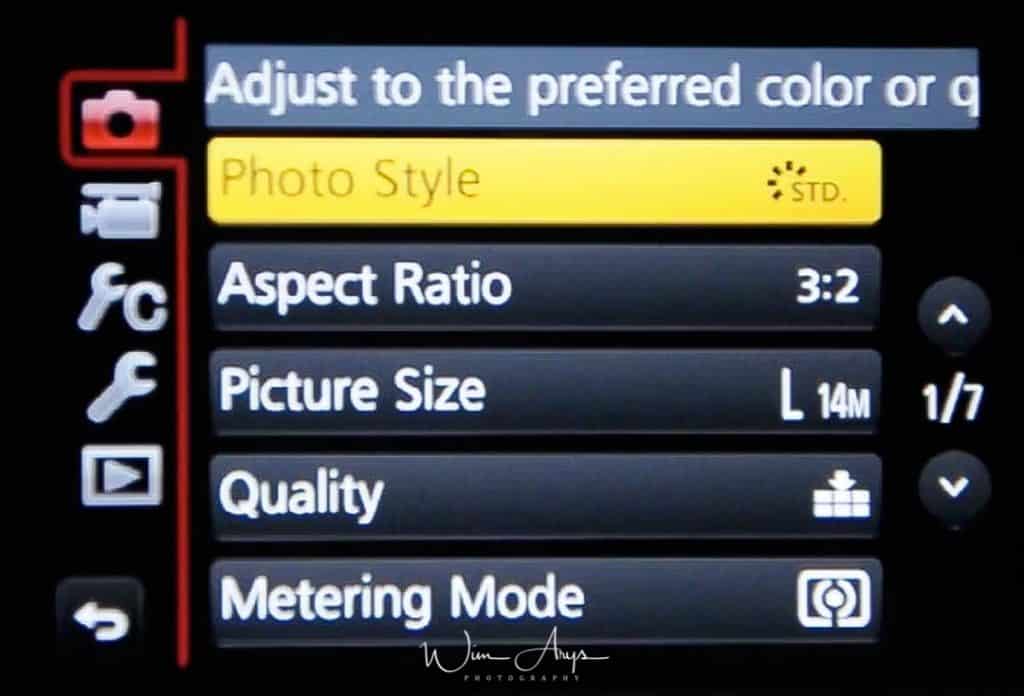
Photo Style
This applies only to Jpeg images, and the RAW preview. You can select a colour effect here.
- Standard: standard Panasonic colour and contrast rendering.
- Vivid: Brilliant effect with high saturation and contrast.
- Natural: Soft effect with low contrast.
- Monochrome: Monochrome (black and white)effect with no color shades.
- L.Monochrome: Black-and-white effect with rich gradation and crisp black accents.
- Scenery: An effect appropriate for sceneries with vivid blue skies and greens.
- Portrait: An effect appropriate for portraits with a healthy and beautiful skin tone.
- Custom 1-4: Make your own presets for easy recall when needed.
it’s possible to create your own Photo Style or customise the preset styles. This is basically a way of hacking into the Jpeg engine and adjusting it to your own style and preferences. There are 6 areas that you can alter.
- Contrast: add or decrease the difference between the brightness and the darkness in the picture.
- Sharpness: add a degree of sharpness or make your images softer.
- Noise Reduction: add noise reduction for high ISO shooting.
- Saturation: add more vividness to the colours. Or remove some.
- Color Tone: add a blue, orange, red or green filter to your image.
Aspect Ratio
You can change the aspect ratio of your photos here. Changing the aspect ratio can be used as a way to boost your creativity, for instance landscapes often look great with a 16:9 ratio, or for sharing on Instagram, a 1:1 crop might suit you better.
An M43 (Micro Four-thirds) camera has a native aspect ratio of (not surprisingly) 4:3. You should realise that changing the aspect ratio to anything else than this will actually crop the sensor, meaning that you’ll lose pixels. You should look at it as re-framing your image (like you can do in Lightroom or other photo editors) inside the Lumix GX7. Jpeg’s will be stored with the chosen ratio, but RAW images (although previewed with the chosen ratio), will still have the full information of the 4:3 sensor retained.
These are the aspect ratios available:
- 4:3: native sensor ratio
- 3:2: the ratio used in full frame cameras
- 16:9: for a wider looking view
- 1:1: Square aspect ratio, mostly used for social sharing
Picture Size
Picture Size sets the number of pixels for Jpeg (nor RAW). The higher the numbers of pixels, the more detail your pictures will have. We’ll have a look at what the number of pixels are when set to Jpeg Large (L).
- When the aspect ratio is set to 4:3, you use all the 16 MP of the sensor for a maximum image size of 4592 x 3448.
- When the aspect ratio is 16:9, you only use a wide crop of the sensor for a maximum image size of 4592 x 2584.
- When the aspect ratio is 3:2 you use a crop of the sensor with an 4592 x 3064 image size.
- When the aspect ratio is 1:1, you use a square crop of the sensor for an 3424 x 3424 image size.
The Panasonic GX7 also has a digital teleconverter option, allowing you to zoom in by a factor of times 2 or times 4. This can be a handy feature if you don’t shoot RAW (see next item for more info). Thanks to in-body digital processing, the resulting Jpegs actually retain a larger image size than what you’d expect of de facto cropping the sensor by a factor 2 or 4. I would however only recommend using this feature if you’re a die hard jpeg shooter, since using RAW files and developing your images in Lightroom or another app will almost always get you better results.
Quality
Probably the most important setting is Quality. You can select either Jpeg, where the RAW data from the sensor is processed by an in-camera algorithm to produce a viewable image, or save your images in this RAW format. RAW retains all the data of the sensor, and is meant to be edited afterwards in a desktop application like Lightroom or Luminar. Saving as RAW means that you have much more creative freedom afterwards to push shadows or pull highlights, sharpen and enhance your image in any way you please. A Jpeg retains only a fraction of this information, according to the algorithm inside the Lumix GX7 which might or might not suit your style and/or needs.
Hence, my recommendation is always to shoot RAW or RAW + Jpeg. This does mean larger files, but SD cards are inexpensive compared to your beautiful new Lumix. But some photographers prefer to shoot in Jpeg only because they are for instance not interested in post-processing images. In this case, I would set the Jpeg to the highest quality setting.
Metering Mode
You can change how the light is metered here, and hence how a correct exposure is calculated by the camera. If you feel that the Lumix GX7 takes over- or underexposed images according to your personal preferences, it might be worth changing the metering mode.
Implementation of this is quite basic in this camera, you have a total of only 3 methods to choose from:
- Multiple: This is the method in which the Panasonic GX7 measures the most suitable exposure by judging the allocation of brightness on the whole screen automatically.
- Center weighted: This is the method used to focus on the subject on the center of the screen and measure the whole screen evenly.
- Spot: This is the method to measure the subject in the spot metering target.
MENU → Camera Icon → page 2 of 7 (also called the Rec menu)
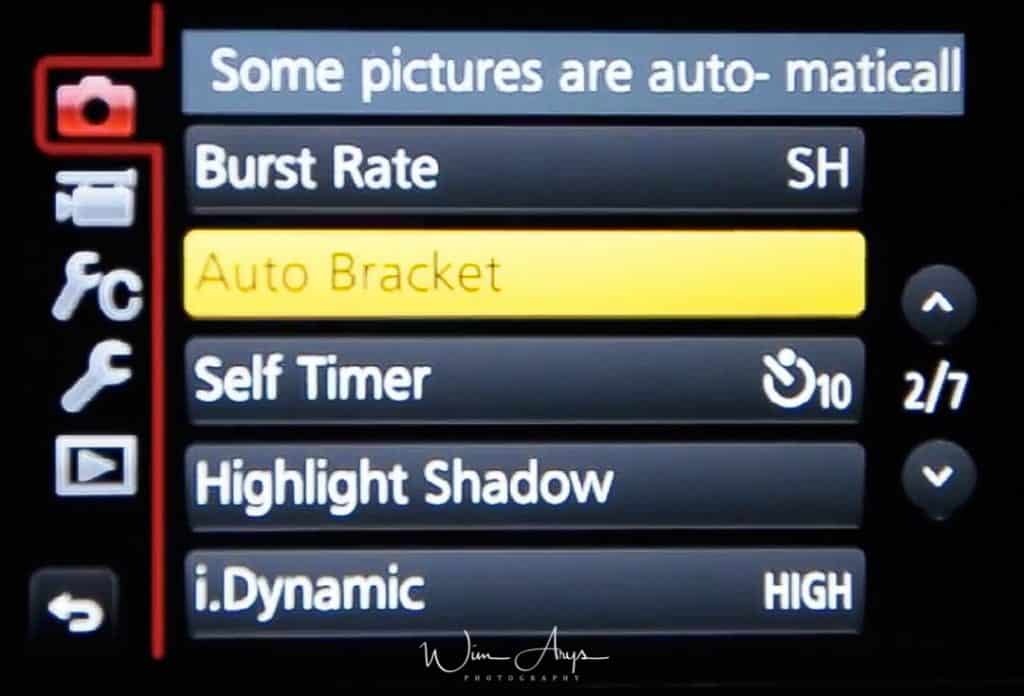
Burst Rate
You can choose your bust shot setting here for continuous drive mode.
Burst shooting means that you’ll shoot continuously when you press the shutter button.
You’ll see SH (for super high burst rates), This SH modes are only available with the electronic shutter. Then we have High, Medium and Low which work with the Mechanical shutter too. The actual burst rate will be higher if you shoot Jpeg only.
Auto Bracket
The Bracket function allows you to take multiple pictures while automatically adjusting a setting like exposure or aperture by pressing the shutter button.
Possible bracket types:
- Exposure Bracket: Press the shutter button and the Lumix will sequentially take multiple images with different exposures. You can select the number of pictures to be taken and the exposure range (from 1/3 EV to 1 EV stops difference).
- Aperture Bracket: Press the shutter button and the Lumix will sequentially take multiple images at different apertures. Either select all apertures or a number of shots (3-5) within a selected range.
- Focus Bracket:Press the shutter button and the Panasonic GX7 will sequentially take multiple images with different focus positions. You can select the distance between focus positions, the number of exposures and the sequence from far to near or the other way around.
- White Balance Bracket: Press the shutter button and the Lumix GX7 will take three pictures with different white balance settings automatically
- White Balance Bracket (color temperature): Press the shutter button once to take three pictures with different White Balance Color Temperature values automatically. You can also set the correction range by touching the up/down slider on the screen.
Self Timer
In this menu, you can select what type of self timer you’d like to use: a 10 second delay and one shot, 10 seconds with 3 shots with 2 second intervals or a 2 second delay, all after pressing the shutter.
Highlight Shadow
This allows you to lighten the shadows and darkens the highlights in your image (or video). So this is a method of creating balance in your image if you feel like the highlights are too strong or the shadows too dark. You have 4 presets available, and you can also make 3 custom presets yourself:
- Standard: no adjustments is set.
- Raise the contrast: Bright areas are brightened, and dark areas are darkened.
- Lower the contrast: Bright areas are darkened, and dark areas are brightened.
- Brighten dark areas: Dark areas are brightened.
- Custom: make your own preset.
This is how to adjust the parameters for Custom presets:
- Rotate the front/rear dial to adjust the brightness of bright/dark portions.
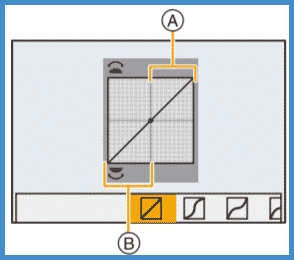
- A – Bright portion
- B – Dark portion
- The rear dial is for adjusting dark areas, and the front dial is for adjusting bright areas.
- To register a preferred setting, press ▲, and select the destination where the custom setting will be registered to [Custom1]/[Custom2]/[Custom3].
- Adjustments can also be made by dragging the graph.
- Press [MENU/SET].
- The screen display can be switched by pressing [DISP.] on the brightness adjustment screen
- .

- Turning off this unit will return the setting adjusted with
 /
/  /
/  /
/  back to the default setting.
back to the default setting.
i. Dynamic
This setting will change contrast and exposure when there is a big difference from the darkest area to the brightest are in your image. What really happens is that the GX7 adjusts the exposure in order to capture more details in the highlights. You can choose between High, Standard, Low or Off.
This naturally causes an under-exposure in the shadow areas. But inside the jpeg engine, the Lumix GX7 will compensate for this by boosting shadows. The downside here is that this will obviously lead to more noise in the boosted regions, but because this is done with data directly coming from the sensor, it can be quite useful if you are a jpeg shooter.
There is also an impact on RAW images, because the exposure will be underexposed.
MENU → Camera Icon → page 3 of 7 (also called the Rec menu)
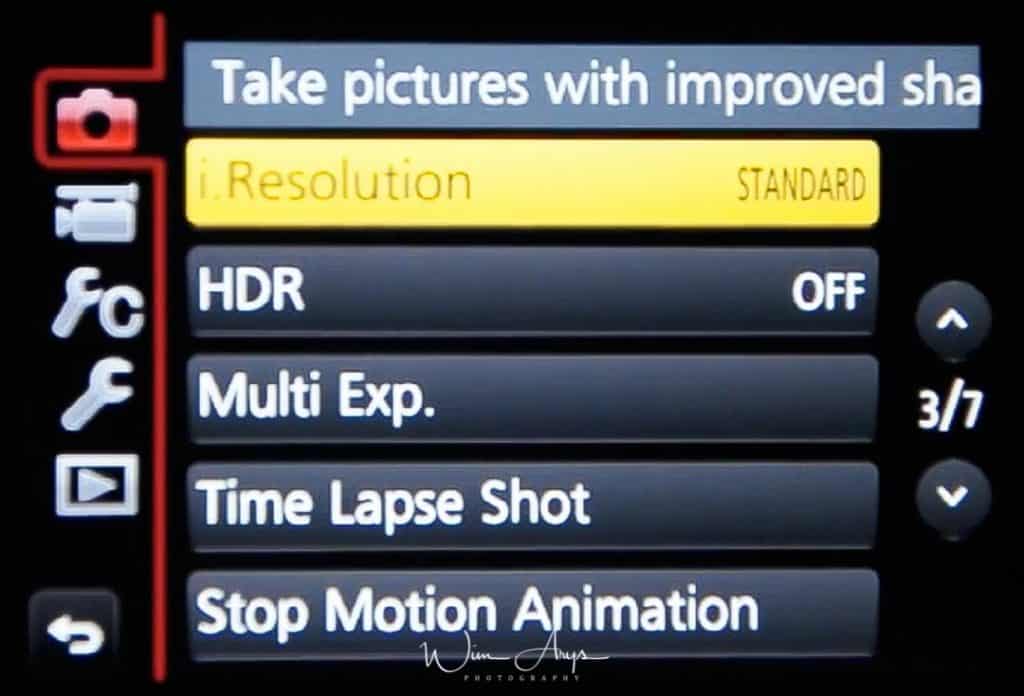
i. Resolution
Another jpeg only functionality, i-Resolution is a form of sharpening. High, Standard, Low and Off are selectable, and you should see these like the threshold for sharpening in an application like Lightroom. Many photographers discard these intelligent functions, and if you shoot RAW only, it’s not that important for you (except i Dynamic which can change your exposure plus or minus 1/3 stop). But if you shoot jpeg only, you should set it to Low at least, since most of the time RAW files would be sharpened in post processing too.
HDR
You can combine 3 pictures with different levels of exposure into a single picture with rich gradation. You can minimize the loss of gradations in bright areas and dark areas when, for example, the contrast between the background and the subject is large.
Two settings are available:
- Dynamic Range: Either set this to auto where the camera decides the exposure difference between shots or plus/minus 1, 2 or 3 EV.
- Auto Align: the Lumix GX7 will align your three shots, for handheld shooting or turn this feature off when you use a tripod.
Multi Exp.
Gives an effect like multi exposure. (layering images on top of each other, up to 4).
- Decide on the composition, and take the first picture.
- After taking the picture, press the shutter button halfway down to take the next picture.
- Press up/down to select the item and then press MENU/SET to either go to the next image, retake your image or exit.$Shooting the second, third, and fourth exposures
- Press down to select Exit and then press MENU/SET.
- Your multiple exposure is made and saved.
Two settings are available:
- Auto gain: the camera automatically adjusts the gain of the separate images to match.
- Overlay: if set to ON, you can apply Multi Exposure to previously recorded images.
Time Lapse Shot
You can take a sequential number of images with relatively long delays in between to achieve a time-lapse movie
- Switch to Time Lapse Shot if it is not selected.
- change start time and shooting interval according to your preferences.
- press te shutter half way to exit the menu.
- press the shutter to start your time-lapse.
Stop Motion Animation
You can take a sequential number of images with relatively long delays in between to achieve a stop motion/animation.
- Switch to Stop Motion Animation
- Change auto shooting and shooting interval according to your preferences
- press te shutter half way to exit the menu.
- press the shutter to start your time-lapse.
- move the subject per frame
- press the folder menu to end the recording
MENU → Camera Icon → page 4 of 7 (also called the Rec menu)
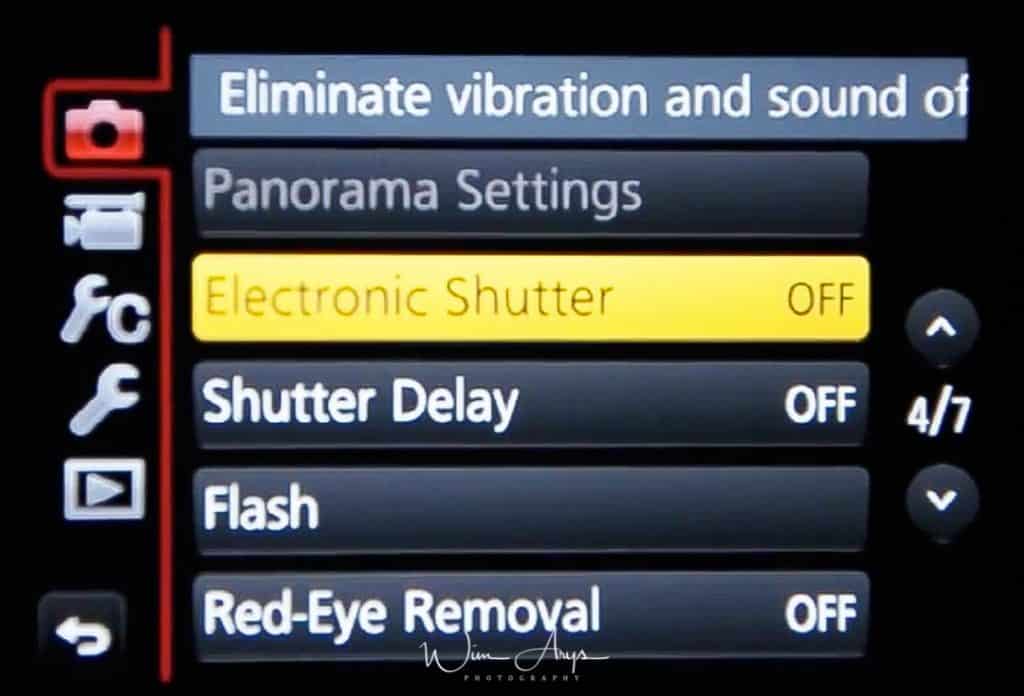
Panorama Settings
You can change settings for the Panorama shot mode on your mode dial here.
- Direction: sets the recording direction to either horizontal or vertical.
- Picture Size: set to either Standard or Wide.
Electronic Shutter
You can use either the mechanical or electronic shutter.
Remember that in artificial light or when using a flash, you best use the mechanical shutter only to avoid artefacts.
Shutter Delay
To reduce the influence of hand shake or shutter vibration, shutter is released after the specified time has passed. 1, 2, 4 or 8 second delay are selectable. Keep your hands steady and don’t use this delay, else you might miss that critical moment.
Flash
You’ll find all the flash functions in this menu for the built-in flash as well as any hotshoe flash you would want to use.
If you’d like to use the built in flash, you’ll need to pop it up using this button:
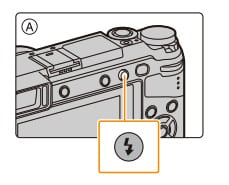
Using a flash takes some skill, but you have a couple of tweaks available for you if you want to make the most of your photography.
Firing Mode
- TTL: The camera automatically sets the flash output. This system meters the light coming through the lens, this includes both ambient and flash light. It calculates the best exposure according to these measurements. Preferred for most users.
- Manual: Set the luminosity ratio of the flash manually. 1/1 means full power, and you can decrease the power to an output that best suits your scenery. It’s not the easiest way to use a flash, but you’ll gain a lot of knowledge in how to balance your flash and ambient light this way.
Flash Mode
like your smartphone camera, you can tell the flash to always be on, turn it off or use a ‘pro’ feature called slow sync. In Slow Sync, the Lumix GX7 will attempt to balance the ambient light with the light of the flash, even in near darkness by slowing down the shutter speed.
These three options are available for the built-in flash. If you’re using a hotshoe flash, or a controller for off camera flashes, you’ll have a few more modes available:
Flash Synchro
- 1st: the flash will sync with the first movement of the shutter (when it opens). This is the normal mode used for normal photography.
- 2nd:The flash fires right before the second operation of an exposure, namely the closing of the shutter.
Second curtain sync is often uses for creative effect, where you’d see the light source appear behind the subject.
Flash Adjust
You can adjust the output power of the flash here in 1/3EV steps in TTL metering mode. In essence, this will give you more or less flash power than when set to zero. If you, for instance , feel that there is always too much flash light in your photos, you could dial it down a little here.
Auto Exposure Comp.
Normally, when you use the compensation dial on the Lumix GX7 body, you’ll also increase or decrease the flash output power. You can turn this OFF here, so the compensation dial will only affect your exposure (brighter or darker) and not flash power.
Wireless Flash Settings
If you want up your game in regards to flash photography, you’ll quickly turn to wireless flashes. These will enable you to use the flash power in a creative way, adjusting power and angle of light by positioning your off-camera flashes differently. Panasonic make a few wireless enabled flashes like the DMW-FL200L, DMW-FL360L or DMW-FL580L, but you can also invest in a few third party brands like Godox. An entire book could be written (and probably has been) on this subject. But for nowWe’ll stick with what is in the menu system.
- Wireless: set to ON if you want to use a wireless flash.
- Wireless Channel: Select the channel you have set for the wireless flashes.
- Wireless Setup: You’ll have three groups of flashes available (A, B and C) as well as your on-camera hotshoe controller flash.. Each flash group can be set to TTL (metering through the lens), Auto, Manual or OFF. You can also dial in flash adjust +-3 EV per group here.
Wireless FP
FP is most commonly known as high speed sync. This system uses a series of high speed flash burst in sync with the shutter in order to achieve flash at high shutter speeds. This is useful in situations where you’d normally be overpowered by sunlight and/or you want to shoot at large apertures for a shallow depth-of-field effect.
You can enable or disable this function for wireless flashes here.
Red-Eye Removal
If you use a flash when using Red-Eye Reduction, the Panasonic GX7 will automatically detect red-eye and corrects the picture.
MENU → Camera Icon → page 5 of 7 (also called the Rec menu)
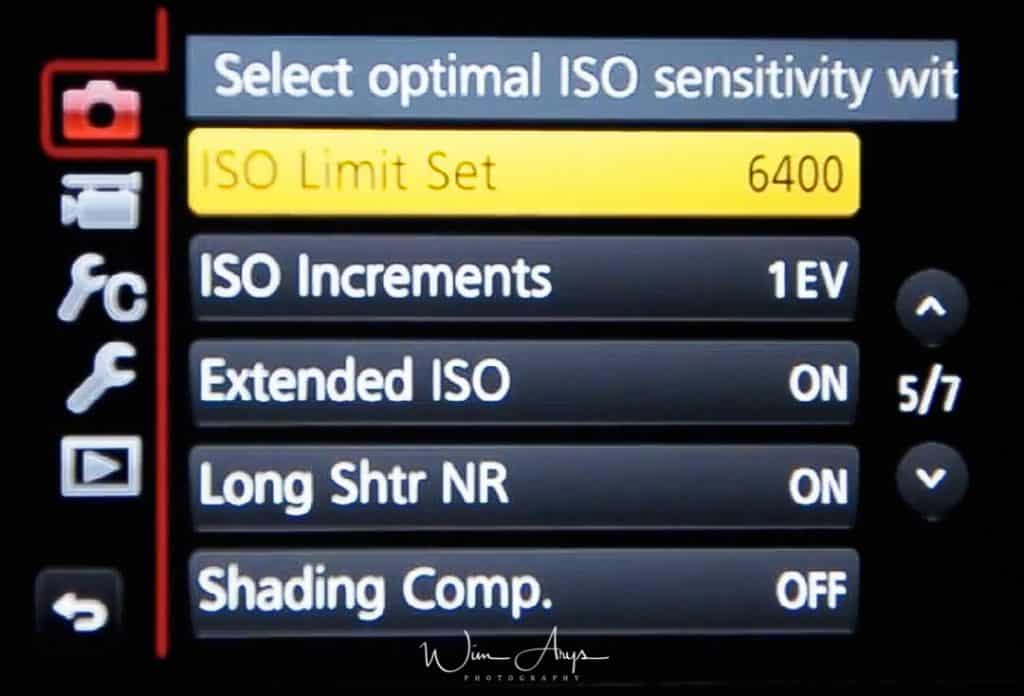
ISO Limit Set
Sets the upper limits of the ISO sensitivity when you use Auto ISO or i ISO. Lower Limit should be set to 200 and upper limit to 1600, this is the range where you’ll get usable images without too much noise.
ISO Increments
Choose the increments of exposure changes between 1/3 EV or 1 EV.
Extended ISO
ISO sensitivity can be set up to minimum of ISO 100. Base ISO of the sensor is 200, so this extended ISO basically halves this in software, with a slight decrease in quality.
Long Shtr NR
The Lumix GX7 will automatically apply noise reduction to long exposures. This applies to both Jpeg and RAW files. A black frame is taken after your initial shot to measure the noise present. Since many environmental factors (like temperature and location) have an effect on the amount of noise that you’ll see, this is the best way to determine what is noise in your frame. This data is then subtracted from your image for a noise-free (more-or-less) result.
Shading Comp.
All lenses have a lens profile that registers both distortion and shading in the corners at all apertures. These lens profiles can be applied in-camera to counter unwanted vignetting in your images. Especially important for jpeg shooters to turn this on. RAW shooters can apply these corrections later on (and with better results) in a desktop application like DXO optics Pro.
MENU → Camera Icon → page 6 of 7 (also called the Rec menu)
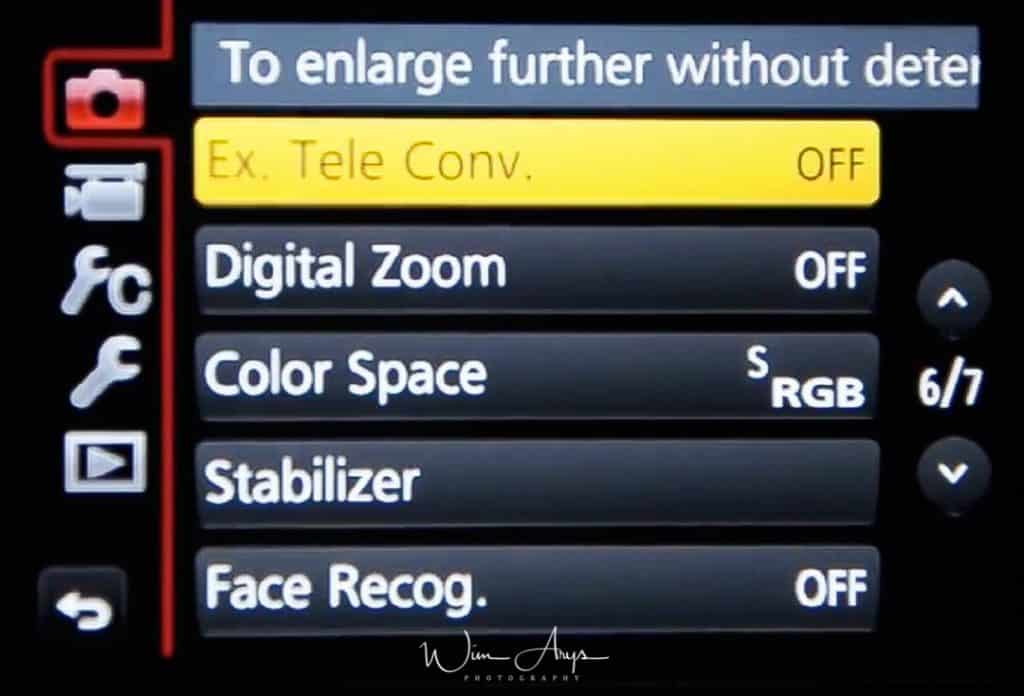
Ex. Tele Conv.
You can digitally enlarge pictures without too much quality deterioration with this function. Only for jpeg use, you can extend the range of your lens by times 1.4 or 1.6 using this function.
Digital Zoom
Digital zoom takes this a step further, allowing you to zoom in up to 4 times for jpeg’s. I would not recommend either of these functions, as it is better to shoot RAW in this case and crop in processing for the best possible quality.
Color Space
Select either sRGB or Adobe RGB here. Adobe RGB has a greater range of reproducible colors than sRGB, so it might be worth looking into this color space if you print to paper a lot. But remember that you’ll also need a monitor capable of reproducing the larger color range too. And this can often lead to problems when converting to sRGB or editing your images in external applications. Because of all this, I have it set to sRGB.
Image Stabilizer
The Panasonic Lumix GX7 has a stabilised sensor. The sensor inside the camera is suspended on a magnetic field and can compensate for movement like the minute shakes of your hands or any other kind of movement. There are also many lenses available with an optical image stabilisation unit, that physically move glass elements around inside the lens to do the same. Both systems have their pros and cons, and it is generally accepted that a stabilised sensor works better for wide angle lenses (below 40mm) whilst optical lens stabilisation is more efficient for the tele range. It is also possible to use both systems at the same time (called Dual I.S. or 5 Axis hybrid for video), where you’ll take advantage of the best of both worlds.
It’s also possible to use the in-body sensor stabilisation with older, manual primes that don’t relay EXIF information (like most importantly focal length in this case). You’ll need to manually set the focal length in the Focal length Set function to get an optimal performance.
Face Recog.
Face Recognition is a function on the Panasonic GX7 which finds a face resembling a registered face and priorities focus and exposure automatically. Even if the person is located towards the back or on the end of a line in a group photo, the camera can still take a clear picture.
On will automatically recognise faces, but you can also register up to six faces yourself.
- In this Menu, select an empty frame (or overwrite one).
- Take an picture of the face you want to register.
- Register this face. Note that you can register up to 3 images per face for more accurate results.
MENU → Camera Icon → page 7 of 7 (also called the Rec menu)
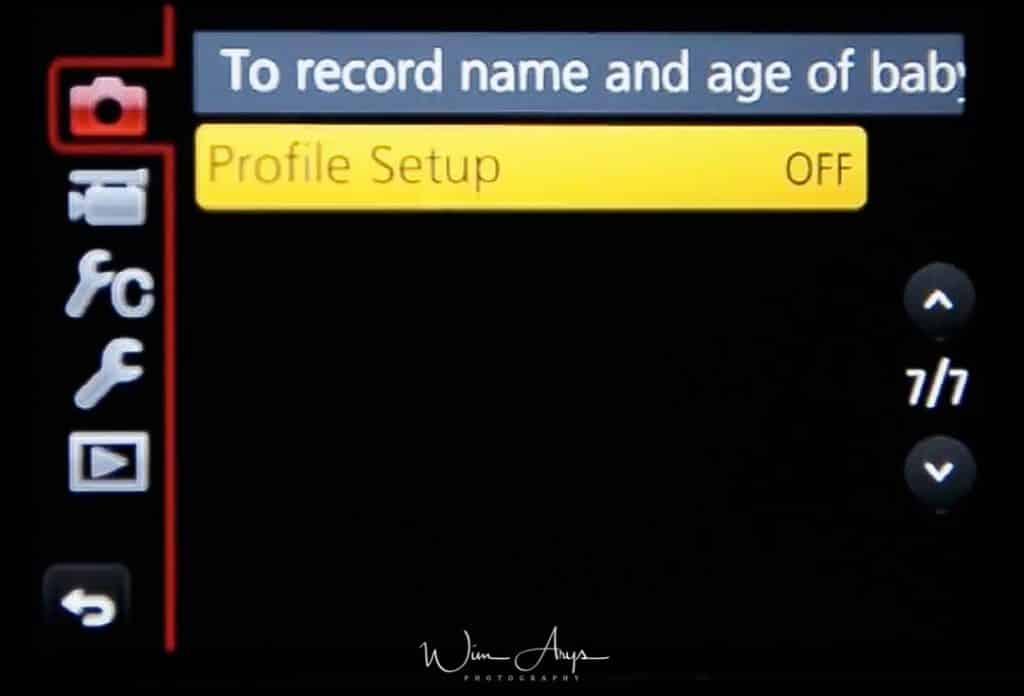
Profile Setup
Setup names and faces of babies or pets so you can track their development mover time.
Select the Profile Setup menu.
- Press up/down to select [SET] and then press [MENU/SET].
- Press up/down to select [Baby1], [Baby2] or [Pet] and then press [MENU/SET].
- Enter age and name of the pet or person.
- Press 4 to select [Exit] and then press [MENU/SET] to finish.
MENU → Film Camera Icon → page 1 of 4 (also called Motion Picture Menu)
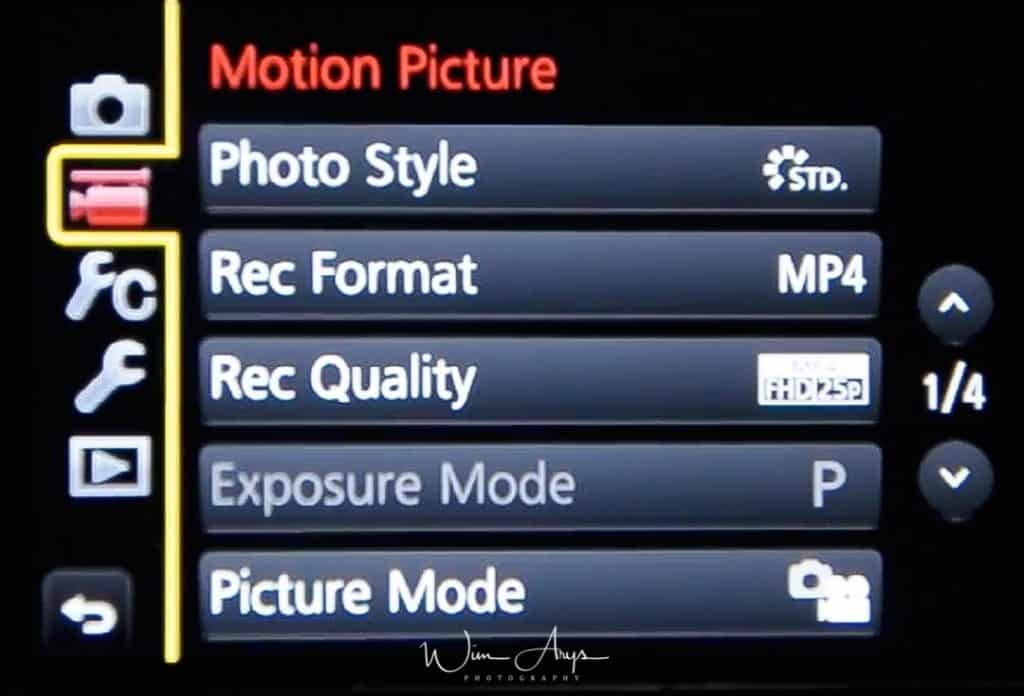
These are all movie related settings, and menu of them are the same as the stills related menu options. You can however (obviously) set them up differently for video.
Photo Style
This applies only to Jpeg images, and the RAW preview. You can select a colour effect here.
- Standard: standard Panasonic colour and contrast rendering.
- Vivid: Brilliant effect with high saturation and contrast.
- Natural: Soft effect with low contrast.
- Monochrome: Monochrome (black and white)effect with no color shades.
- L.Monochrome: Black-and-white effect with rich gradation and crisp black accents.
- Scenery: An effect appropriate for sceneries with vivid blue skies and greens.
- Portrait: An effect appropriate for portraits with a healthy and beautiful skin tone.
- Custom 1-4: Make your own presets for easy recall when needed.
it’s possible to create your own Photo Style or customise the preset styles. This is basically a way of hacking into the Jpeg engine and adjusting it to your own style and preferences. There are 6 areas that you can alter.
- Contrast: add or decrease the difference between the brightness and the darkness in the picture.
- Sharpness: add a degree of sharpness or make your images softer.
- Noise Reduction: add noise reduction for high ISO shooting.
- Saturation: add more vividness to the colours. Or remove some.
- Color Tone: add a blue, orange, red or green filter to your image.
Rec Format
You can either choose to record in AVCHD or MP4 format. The higher the Bit rate value is, the higher the picture quality becomes. Since the Panasonic Lumix GX7 employs the VBR recording method, the bit rate is changed automatically depending on the subject to record. As a result, the recording time is shortened when a fast-moving subject is recorded. Different frame rates and bitrates are selectable per format in the Rec Quality setting.
Rec Quality
Select the quality of video here.
AVCHD

MP4

Exposure Mode
You can select the exposure mode for video here. Choose between these modes:
- Program (P): A semi-auto mode that automatically selects aperture and shutter time.
- Aperture (A): Choose the aperture and the GX7 will adjust the shutter speed accordingly.
- Shutter (S): Choose the shutter speed and the camera will adjust the aperture and ISO automatically according to your preferences.
- Manual (M): select both aperture and shutter speed manually.
Picture Mode
Recording method for the still pictures taken while recording a motion picture can be set with Picture Mode in the Motion Picture menu.
Motion picture priorities
- Pictures will be recorded with a picture size of S. The picture quality may be different to S of standard pictures.
- Only JPEG images are recorded when Quality]is set to RAW,
- Up to 40 still pictures can be taken during recording of the motion picture.
- In Miniature Effect of Creative Control Mode, there may be a slight delay between fully pressing the shutter button and recording.
Still picture priorities
- Pictures will be recorded with the set picture size and quality.
- The screen will go dark while recording pictures. A still picture will be recorded in the motion picture during that period, and audio is not recorded.
- Up to 10 still pictures can be taken during recording of the motion picture.
MENU → Film Camera Icon → page 2 of 4 (also called Motion Picture Menu)
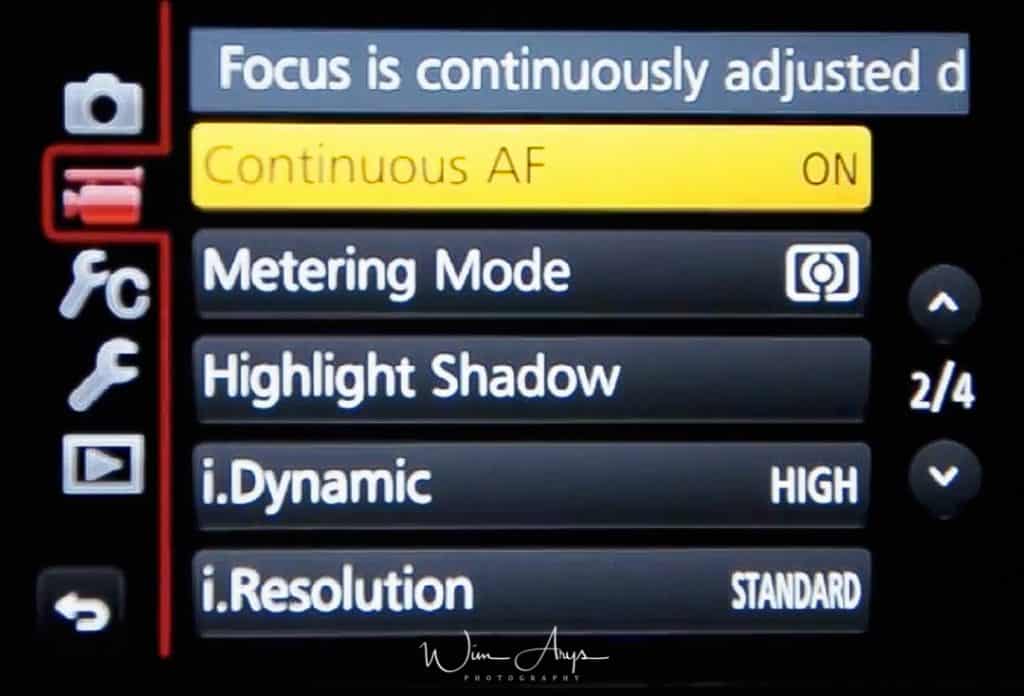
Continuous AF
Focusing changes depending on the Focus Mode setting and the Continuous AF setting in this menu.
AFS/AFF/AFC:
- On: The camera automatically keeps focusing on subjects during recording.
- Off: The Lumix GX7 maintains the focus position at the start of recording.
MF
You can use manual focus.
Metering Mode
You can change how the light is metered here, and hence how a correct exposure is calculated by the camera. If you feel that the Lumix GX7 takes over- or underexposed images according to your personal preferences, it might be worth changing the metering mode.
Implementation of this is quite basic in this Panasonic, you have a total of only 3 methods to choose from:
- Multiple: This is the method in which the camera measures the most suitable exposure by judging the allocation of brightness on the whole screen automatically.
- Center weighted: This is the method used to focus on the subject on the center of the screen and measure the whole screen evenly.
- Spot: This is the method to measure the subject in the spot metering target.
Highlight Shadow
This allows you to lighten the shadows and darkens the highlights in your image (or video). So this is a method of creating balance in your image if you feel like the highlights are too strong or the shadows too dark. You have 4 presets available, and you can also make 3 custom presets yourself:
- Standard: no adjustments is set.
- Raise the contrast: Bright areas are brightened, and dark areas are darkened.
- Lower the contrast: Bright areas are darkened, and dark areas are brightened.
- Brighten dark areas: Dark areas are brightened.
- Custom: make your own preset.
For more info, see the equivalent setting for photos above.
i.Dynamic
This setting will change contrast and exposure when there is a big difference from the darkest area to the brightest are in your image. What really happens is that the camera adjusts the exposure in order to capture more details in the highlights. You can choose between High, Standard, Low or Off.
This naturally causes an under-exposure in the shadow areas. But inside the jpeg engine, the Lumix GX7 will compensate for this by boosting shadows. The downside here is that this will obviously lead to more noise in the boosted regions, but because this is done with data directly coming from the sensor, it can be quite useful.
i.Resolution
i-Resolution is a form of sharpening. High, Standard, Low and Off are selectable, and you should see these like the threshold for sharpening in an application like Lightroom. Many photographers discard these intelligent functions, and if you shoot RAW only, it’s not that important for you (except i Dynamic which can change your exposure plus or minus 1/3 stop).
MENU → Film Camera Icon → page 3 of 4 (also called Motion Picture Menu)
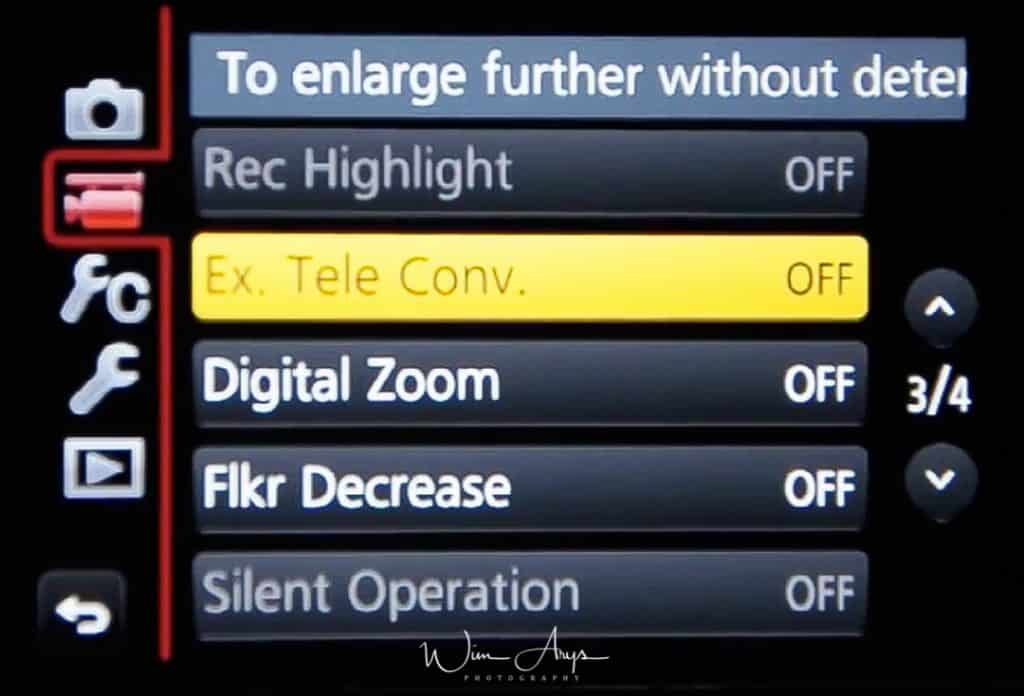
Rec Highlight
White saturated areas appear blinking in black and white. f there are any white saturated areas, I recommend compensating the exposure towards negative referring to the histogram and then recording.
Ex. Tele Conv.
You can digitally enlarge movies without too much quality deterioration with this function. You can extend the range of your lens by times 1.4 or 1.6 using this function.
Digital Zoom
Digital zoom takes this a step further, allowing you to zoom in up to 4 times.
Flkr Decrease
The shutter speed can be fixed to reduce the flicker or striping in your movies. 1/50,/1/60,1/100 or 1/120 second are available.
Silent Operation
The operational sound of the zoom or button operation may be recorded when it is operated during the recording of a motion picture. Using touch icons allows silent operation while recording motion pictures.
These are the icons available:
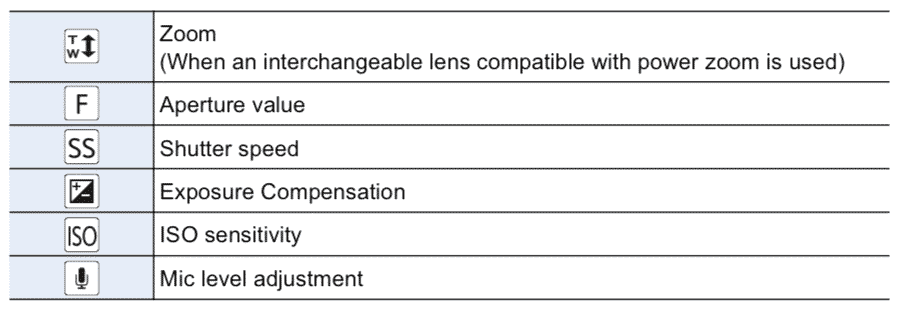
MENU → Film Camera Icon → page 4 of 4 (also called Motion Picture Menu)
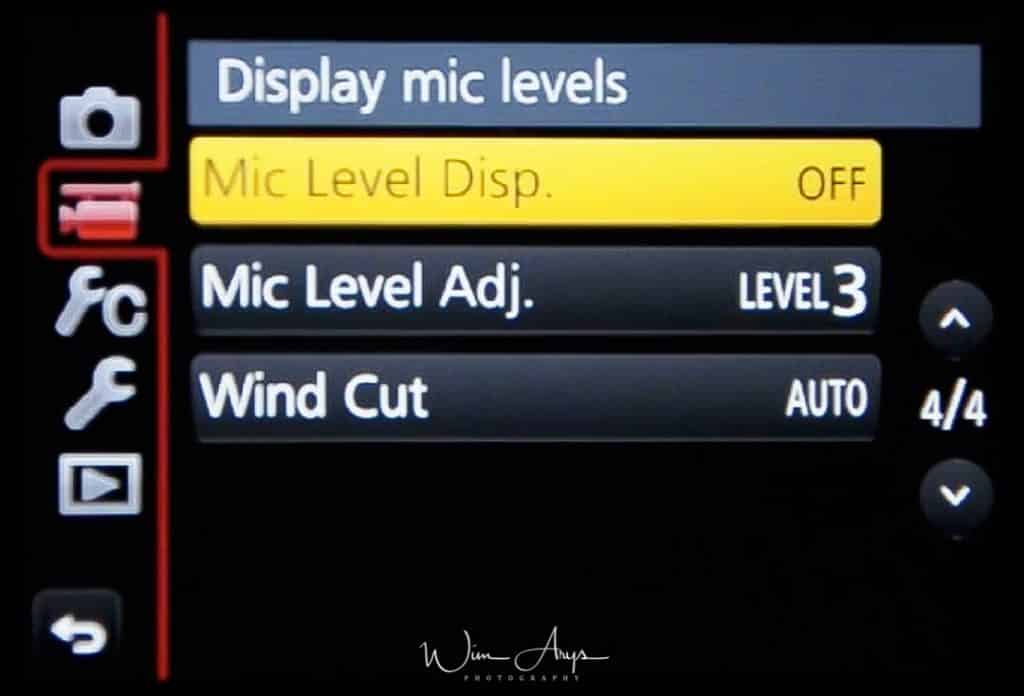
Mic Level Disp.
Select if you want to display the microphone level on the recording screen.
Mic Level Adj.
Adjust the sound input level to 19 different levels (-12 dB to +6 dB).
Wind Cut
This will reduce the wind noise coming into the built-in microphone while maintaining sound quality. You can choose either High, Standard or Off. This function works only with the built-in microphone.
Custom settings page 1 of 8
You’ll find all customisable settings of the Panasonic GX7 in this Menu.
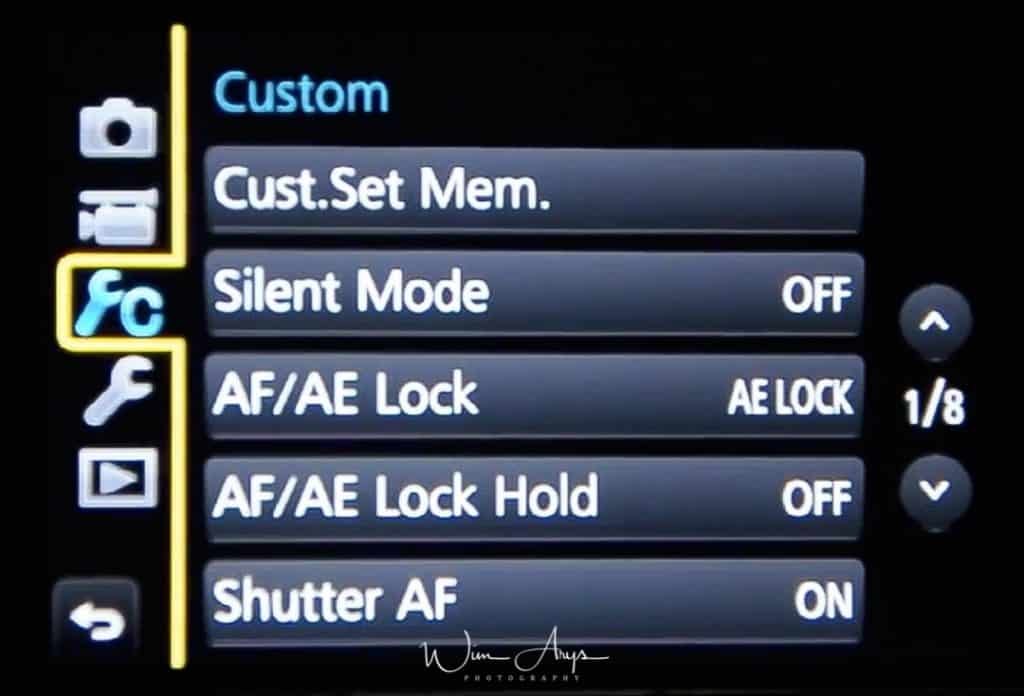
Cust. Set Mem.
Up to 3 sets of current camera settings can be registered using C1, C2, C3-1, C3-2 or C3-3. These are directly accessible via the Mode Dial.
Saving a custom setting is quite simple, set the mode dial to C1, C2 or C3, change the cameras settings to your preferences, go in the Menu to this setting and press MENU/SET on the screen.
Silent Mode
Disables operational sounds and output of light at once. • Audio from the speaker will be muted and the flash and the AF Assist lamp will be disabled.
The following settings are fixed:
- Shutter Type: ESHTR.
- Flash Mode:forced flash off.
- AF Assist Lamp: Off.
- Beep Volume: Off.
- E-Shutter Volume: Off.
AF/AE Lock
Lock focus and exposure with AF/AE LOCK. To clear the lock, press AF/AE LOCK again.
AF/AE Lock Hold
When ON is selected, focus and exposure stays locked even if you press and release AF/AE LOCK. To clear the lock, press AF/AE LOCK again.
Shutter AF
Set whether or not the focus is adjusted automatically when the shutter button is pressed halfway.
Custom settings 2 of 8
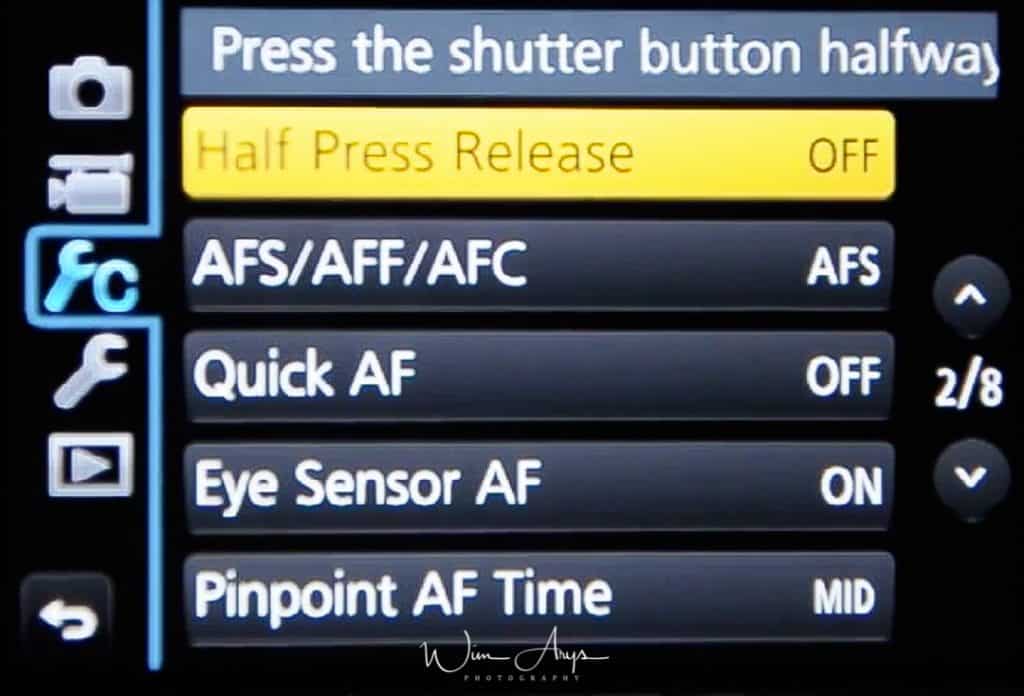
Half Press Release
The shutter will immediately fire when the shutter button is pressed halfway when this is ON.
AFS/AFF/AFC
You can change autofocus modes here. Select focus mode according to the movement of the subject and the scene you are recording. The set focus mode will be assigned to AF of the focus mode lever.
- AFS: Subject is still. AFS” is an abbreviation of “Auto Focus Single”. Focus is set automatically when the shutter button is pressed halfway. Focus will be fixed while it is pressed halfway.
- AFF: Movement cannot be predicted. “AFF” is an abbreviation of “Auto Focus Flexible”. In this mode, focusing is performed automatically when the shutter button is pressed halfway. If the subject moves while the shutter button is pressed halfway, the focus is corrected to match the movement automatically.
- AFC: Subject is moving. “AFC” is an abbreviation of “Auto Focus Continuous”. In this mode, while the shutter button is pressed halfway, focusing is constantly performed to match the movement of the subject. When the subject is moving, the focusing is performed by predicting the subject position at the time of recording.
Quick AF
As long as the camera is held steady, the Lumix GX7 will automatically adjust the focus and focus adjustment will then be quicker when the shutter is pressed. You’ll get better AF performance at the expense of battery life.
Eye Sensor AF
The Panasonic GX7 will automatically start autofocus when the eye sensor is activated.
Pinpoint AF Time
Sets the time for which the screen is enlarged when the shutter button is pressed halfway with Auto Focus Mode set to MF assist.
Custom settings page 3 of 8
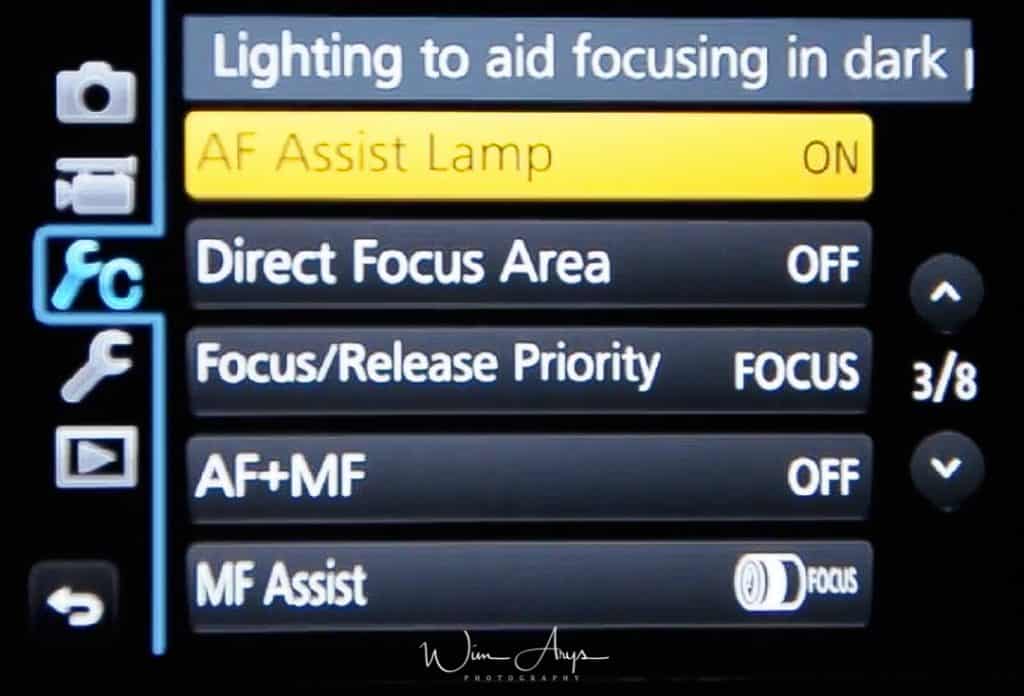
AF Assist lamp
AF assist lamp will illuminate the subject when the shutter button is pressed half-way making it easier for the camera to focus when recording in low light conditions. Range is about 1 meter.
Direct Focus Area
Moves the AF area or MF assist using the cursor button when recording.
Focus/release Priority
This will prevent you from taking pictures when focus is not achieved.
AF+MF
When AF Lock is ON (press the shutter button halfway with the focus mode set to AFS or set AF Lock using AF/AE LOCK), you can make fine adjustments to the focus manually.
MF Assist
Sets the display method of MF Assist (enlarged screen) on the Panasonic GX7.

Custom settings page 4 of 8
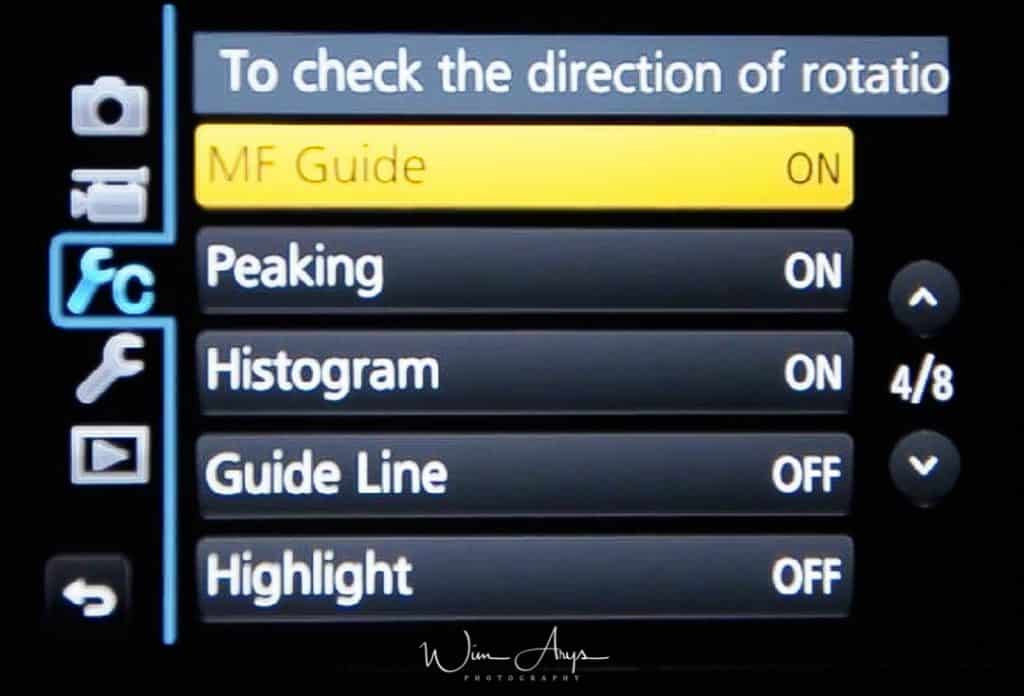
MF Guide
When you set the focus manually, an MF guide that allows you to check the direction to achieve focus is displayed.
Peaking
In-focus portions (portions on the screen with clear outlines) are highlighted when focus is being adjusted manually. Great focussing aide for manual focussing. Can be set to High or Low.
Histogram
Display the histogram. A histogram is a graph that displays brightness along the horizontal axis (black to white) and the number of pixels at each brightness level on the vertical axis. It allows you to easily check a picture’s exposure.
Guide Line
This will set the pattern of guide lines displayed when taking a picture.
Highlight
When the Auto Review function is activated or when playing back, white saturated areas appear blinking in black and white.
Custom settings page 5 of 8
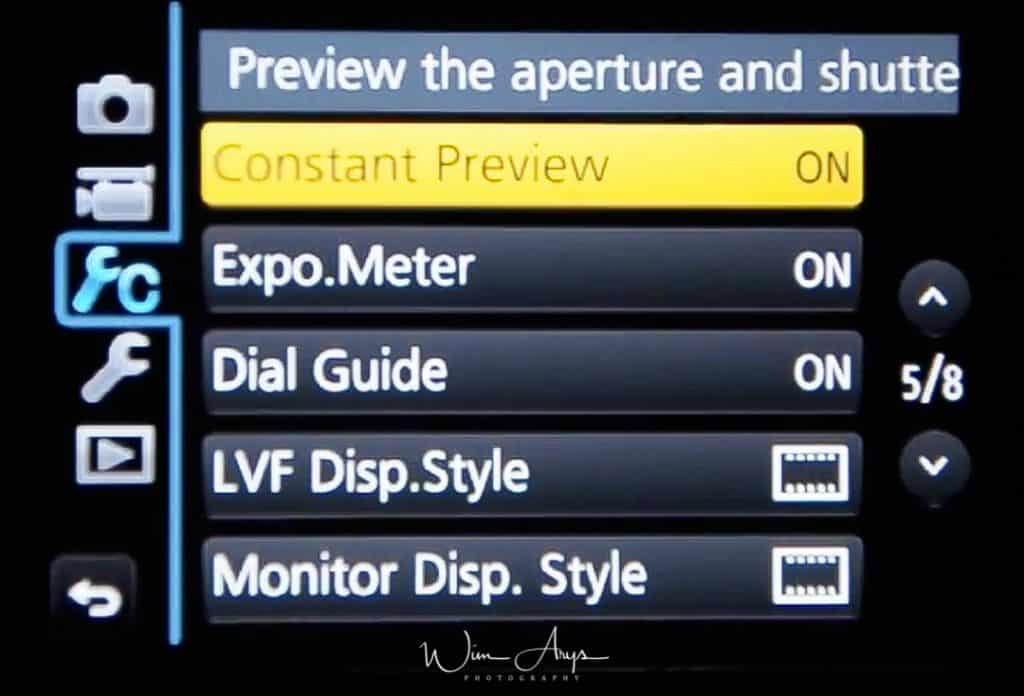
Constant Preview
You can check the effects of the chosen aperture and shutter speed on the recording screen in Manual Exposure Mode. Some camera makers call this Live View.
Expo.Meter
Display the exposure meter.
- Set to ON to display the Exposure meter when performing Program Shift, setting aperture, and setting shutter speed.
- Unsuitable areas of the range are displayed in red.
- When the Exposure meter is not displayed, switch the display information for screen by pressing DISP.
- If no operations are performed for approximately 4 seconds, the Exposure meter disappears.
Dial Guide
When turned on, the operation guide for dials, buttons, etc. is displayed on the recording screen. (Like you see on the screenshots)
LVF Disp. Style
This will set the display style of the viewfinder. You can choose between detailed information (icons), tilt sensor display or without any information.
Monitor Disp. Style
This will set the display style of the screen. Here too, you can choose between detailed information (icons), tilt sensor display or without any information.
Monitor style:
Scales images to fill the entire screen so that you can see their details.
Custom settings page 6 of 8
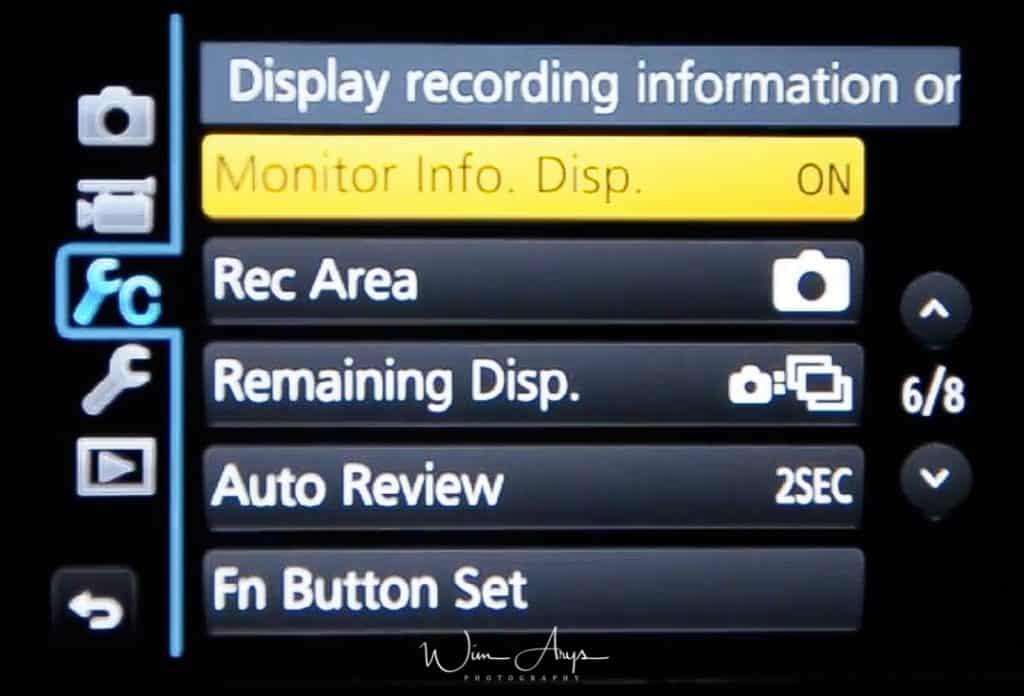
Monitor Info. Disp.
Display the recording information screen.
Viewfinder style: Scales down images slightly so that you can better review the composition of the images.
Monitor style: Scales images to fill the entire screen so that you can see their details.
Rec Area
This changes the angle of view during motion picture recording and still picture recording. Displays the recording area according to the angle of view for still picture recording or video.
Remaining Disp.
This will switch display between the number of recordable pictures and available recording time.
Auto Review
Displays a picture immediately after it is taken.
FN Button Set
You can assign various recording and other functions to the function buttons.
Custom settings page 7 of 8
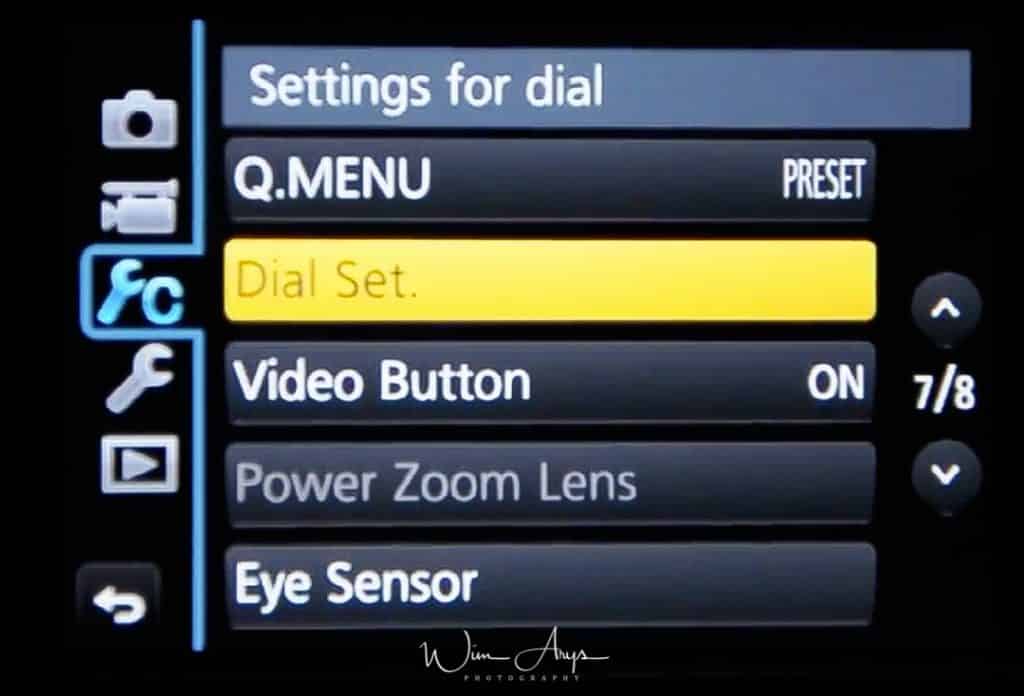
Q.MENU
In Custom operations, you can customise the Q Menu according to your liking.
You can add a maximum of 15 preferred settings to the Quick Menu.
- Press Q.MENU to display the Quick Menu.
- Press down to select the custom tool and then press MENU/SET.
- Press left/right arrow to select the menu item in the top row and then press MENU/SET.
- Press left/right to select the empty space in the bottom row and then press MENU/SET. (You can also set the menu item by dragging it from the top row to the bottom row)
- Press return to switch to the recording screen.
Dial Set.
Assign Dial (F/SS): Assigns the operations of the aperture value and shutter speed in Manual Exposure Mode.
Rotation (F/SS): Changes the rotation direction of the dials for adjusting the aperture value and shutter speed.
Control Dial Assignment: It sets the item to be assigned to the control dial while the recording screen is displayed.
Exposure Comp.: Assigns the Exposure Compensation to the front dial or rear dial so that you can directly adjust it.
Dial Operation Switch Setup: Sets the items to be assigned temporarily to the front/rear dials when you press the function button to which Dial Operation Switch is assigned.
Video Button
Enables/disables the motion picture button.
Power Zoom Lens
Change the settings for a power zoom lens. Sets the screen display and lens operations when using an interchangeable lens that is compatible with power zoom.
- Disp Focal Length: When you zoom, the focal distance is displayed and you can confirm the zoom position.
- Step Zoom: When you operate the zoom with this setting [ON], the zoom will stop at positions corresponding to predetermined distances.
- Zoom Speed: You can set the zoom speed for zoom operations for both stills and vide to high, medium or low.
- Zoom Ring: When set to OFF] the operations controlled by the zoom ring are disabled to prevent accidental operation.
Eye Sensor
This sets the automatic viewfinder/monitor switching functionality. Automatic viewfinder/monitor switching enables the eye sensor to switch the display to the viewfinder automatically when you bring your eye or an object near it.
You can select whether to Turn off the monitor when the EVF is engaged with the Eye sensor, and also the Eye Sensor sensitivity.
Custom settings page 8 of 8
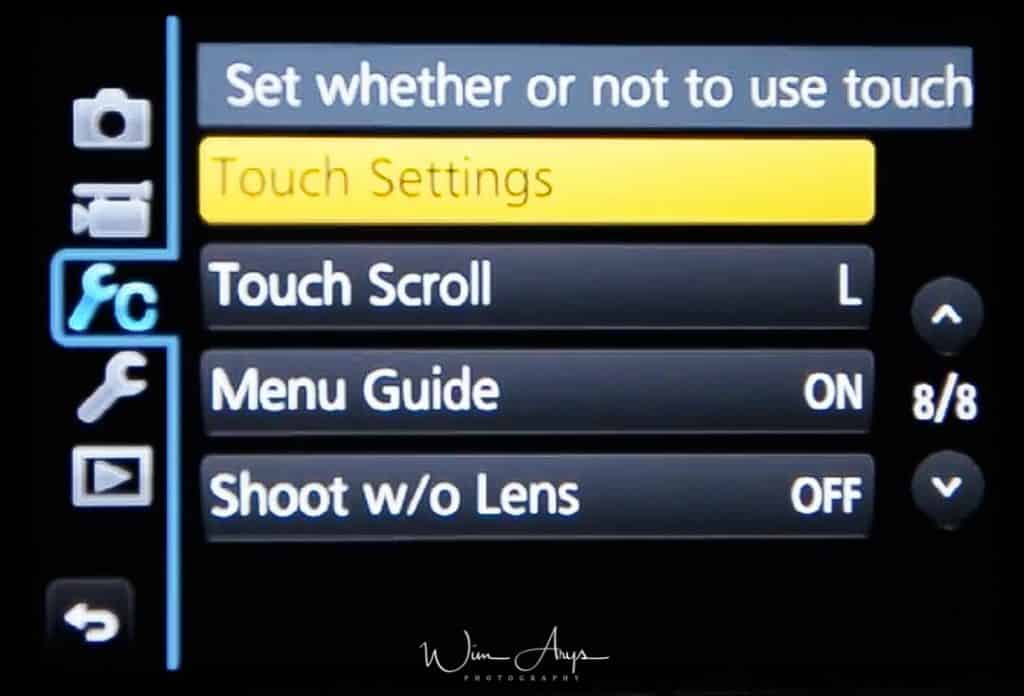
Touch Settings
Enables/disables the Touch screen operation.
- Touch Screen: All touch operations are turned on.
- Touch Tab: Operations of tabs are enabled.
- Touch AF: Operation to bring the subject you touch into focus AF or adjust the focus and brightness AF+AE are enabled.
- Touch Pad AF: Operation to move the AF area by touching the monitor when the viewfinder is in use.
Touch Scroll
This allows you to set the speed of continuously forwarding or rewinding pictures using touch operation.
Menu Guide
Sets whether or not to display a selection screen when you set the mode dial to SCN.
Shoot w/o Lens
Sets whether or not the shutter can be released when no lens is attached to the main body.
MENU → Setup Menu → page 1 of 6 (General Camera Setup)
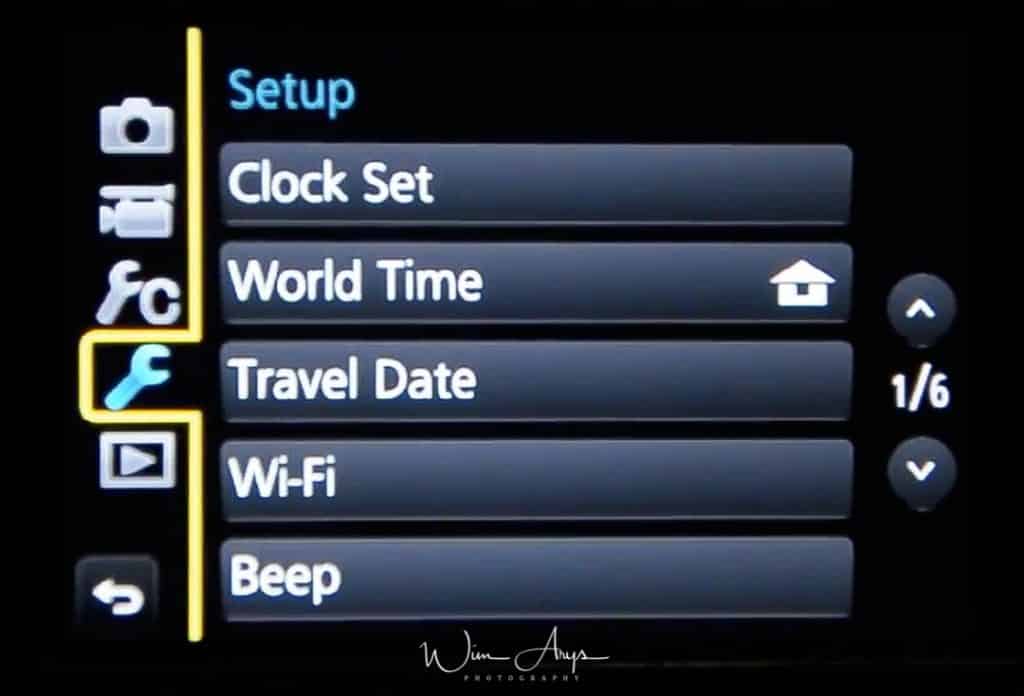
Clock Set
You have already probably set time and date when you first turned on the Panasonic GX7, but you can also change this here.
World Time
Sets the times for the region where you live (HOME) and your travel destination (DESTINATION). Time and date will be altered to reflect the local time and date at your travel destination.
Travel Date
If you set Travel Setup, elapsed days of your trip i.e. which day of the trip based on its departure and return dates will be recorded The travel date is automatically canceled if the current date is after the return date.
If you set Location, the name of the travel destination that you enter will be recorded.
Wi-Fi
It’s possible to control your Panasonic GX7 with a smartphone or a tablet, display pictures on TV, print Wirelessly, Send images to a PC or use Web Services from Panasonic all via WiFi.
To use the Wi-Fi function on this camera, a wireless access point is needed off course.
By default, Wi-Fi is assigned to the Fn6 button when the Lumix GX7 is in Recording Mode, while it is assigned to Fn1 when the camera is in Playback Mode. You can assign it to any button you want.
When you want to connect to WiFi, simply press this button.
Wi-Fi Setup
Priority of Remote Device: Sets either the camera or the smartphone as the priority control device to be used during remote recording.
Wi-Fi Password: You can improve security by enabling password entry for a direct connection to a smartphone.
LUMIX CLUB: Acquires or changes the “LUMIX CLUB” login ID.
PC Connection: You can set the workgroup. To send images to a PC, a connection to the same workgroup as the destination PC is required.
Device Name: You can change the name (SSID) of this unit.
Wi-Fi Function Lock: To prevent incorrect operation and use of the Wi-Fi function by a third party and to protect saved personal information, protect the Wi-Fi function with a password.
Network Address: Displays the MAC address and IP address of this unit.
Approved Regulations: Displays the certification number for radio regulations.
Beep
This allows you to set the electronic sound and the electronic shutter sound. Remember this will be off if you’re in Silent Mode!
MENU → Setup Menu → page 2 of 6 (General Camera Setup)
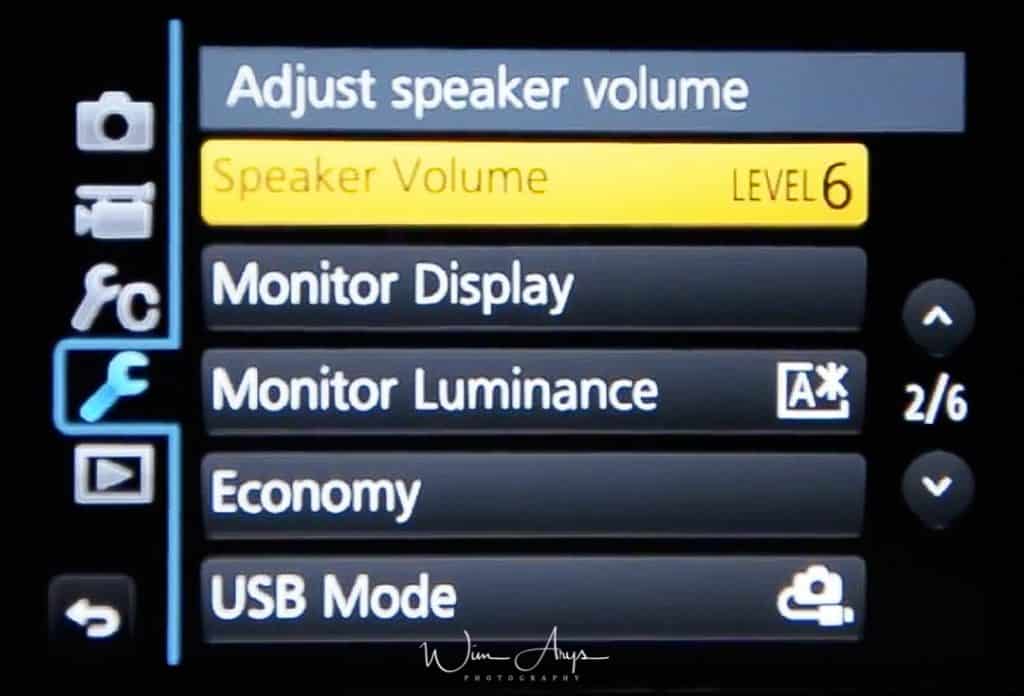
Speaker Volume
Adjust the volume of the speaker to any of the 7 levels.
Monitor Display
Brightness, color, or red or blue tint of the Monitor/viewfinder can be adjusted.
Monitor Luminance
These settings will affect how and when brightness of the monitor is adjusted.
Auto: The brightness is adjusted automatically depending on how bright it is around the camera.
- Mode 1: Makes the monitor brighter than normal.
- Mode 2: Set the monitor to the standard brightness.
- Mode 3: Makes the monitor brighter than standard.
Economy
These settings will determine the way the camera handles inactivity on your part to save battery life.
- Sleep Mode: The camera is automatically turned off if the Lumix GX7 has not been used for the time selected on the setting.
- Sleep Mode(Wi-Fi): The camera is automatically turned off if it is not connected to a Wi-Fi network and has not been used for 15 minutes (
- Auto LVF/ Monitor Off: The monitor/viewfinder is automatically turned off if the camera has not been used for the time selected on the setting.
- Power Save LVF Shooting: If you display the monitor using the viewfinder/monitor automatic switching function, the camera will turn off automatically after being left idle.
USB Mode
Sets the communication method when connecting using the USB connection cable.
- Select on Connection: Select this setting to select the USB communication system when connecting to another device.
- PC Storage: Select this setting to export images to a connected PC.
- PC Tether: Select this setting to control the camera from a PC installed with supported software.
- Pictbridge PTP: Select this setting when connecting to a printer supporting PictBridge.
MENU → Setup Menu → page 3 of 6 (General Camera Setup)
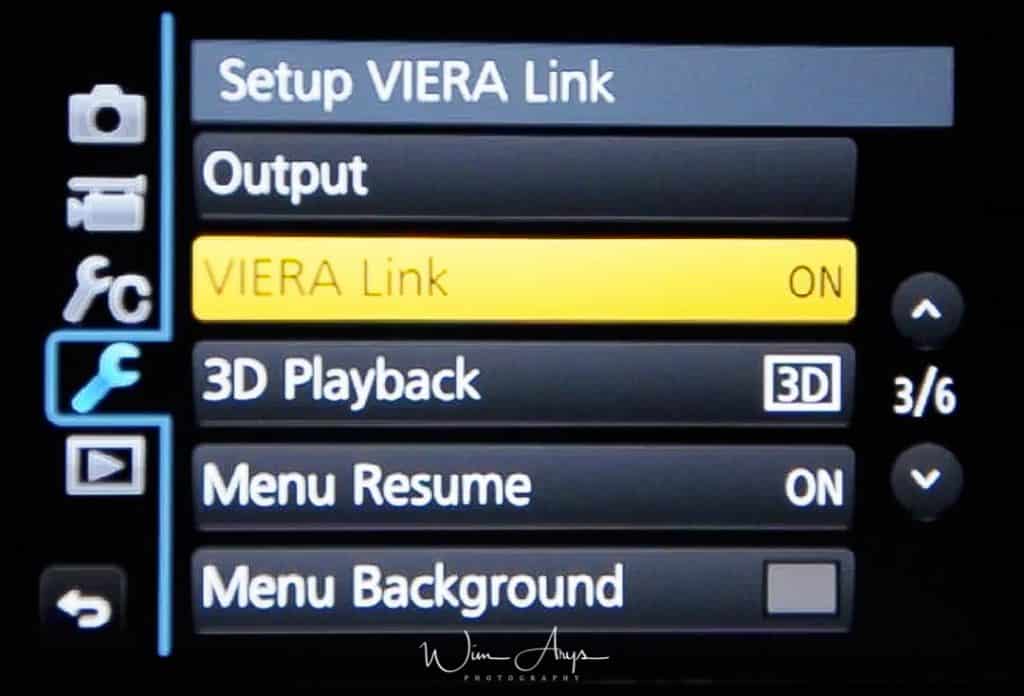
Output
This sets how the unit connects to a television etc.
TV Aspect
- 16:9: When connecting to a 16:9 screen TV.
- 4:3:When connecting to a 4:3 screen TV.
HDMI Mode
Set the format for the HDMI output when playing back on the HDMI compatible high-definition TV connected with this unit using the HDMI mini cable.
- AUTO: The output resolution is automatically set based on the information from the connected TV.
- 1080p: The progressive method with 1080 available scan lines is used for output.
- 1080i:The interlace method with 1080 available scan lines is used for output.
- 720p: The progressive method with 720 available scan lines is used for output.
- 480p:The progressive method with 480 available scan lines is used for output.
VIERA Link
Settings that allow this unit to be controlled by the remote control of the VIERA equipment by automatically coupling this unit with the VIERA Link compatible equipment using HDMI mini cable.
3D Playback
Set the output method for 3D pictures.
Menu Resume
Stores the location of the last-used menu item for each menu, so that when you enter that menu, the last opened page is used.
Menu Background
Set the background color for the menu screen.
MENU → Setup Menu → page 4 of 6 (General Camera Setup)
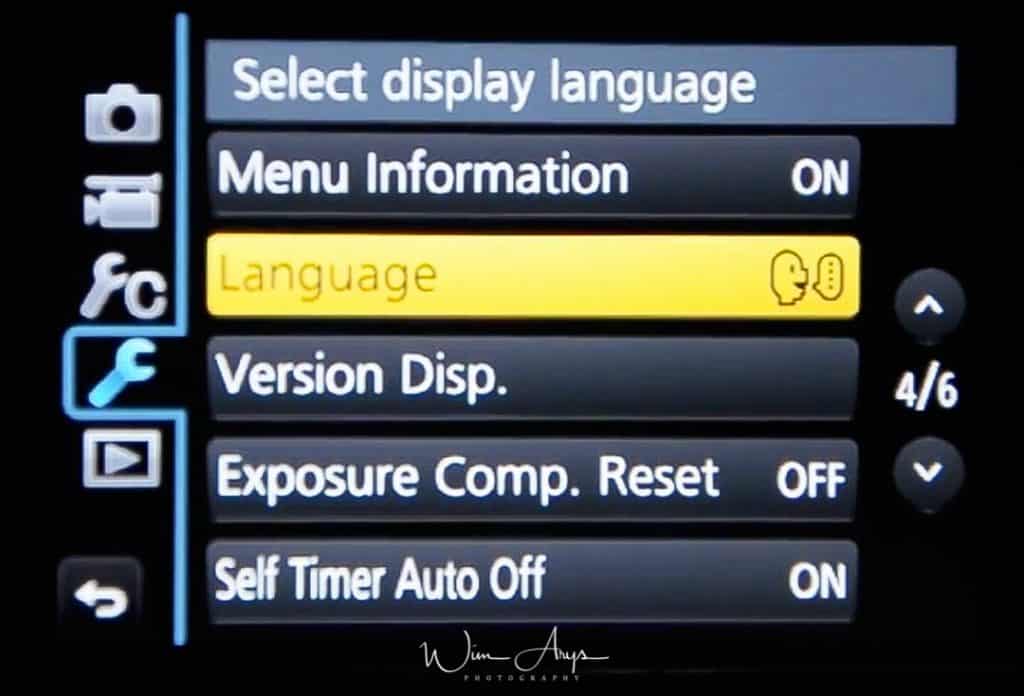
Menu Information
Descriptions of menu items or their settings are displayed on the menu screen.
Language
Set the language displayed on the screen.
Version Disp
This enables the firmware versions of the camera and lens to be checked before an upgrade for instance.Folder/File Settings
Set the folder and file name patterns in which images are to be saved.
Exposure Comp. Reset
The exposure value used previously can be reset when the Recording Mode is changed or the Lumix GX7 is turned off.
Self Timer Auto Off
Set whether to cancel the self-timer when the unit is turned off.
MENU → Setup Menu → page 5 of 6 (General Camera Setup)
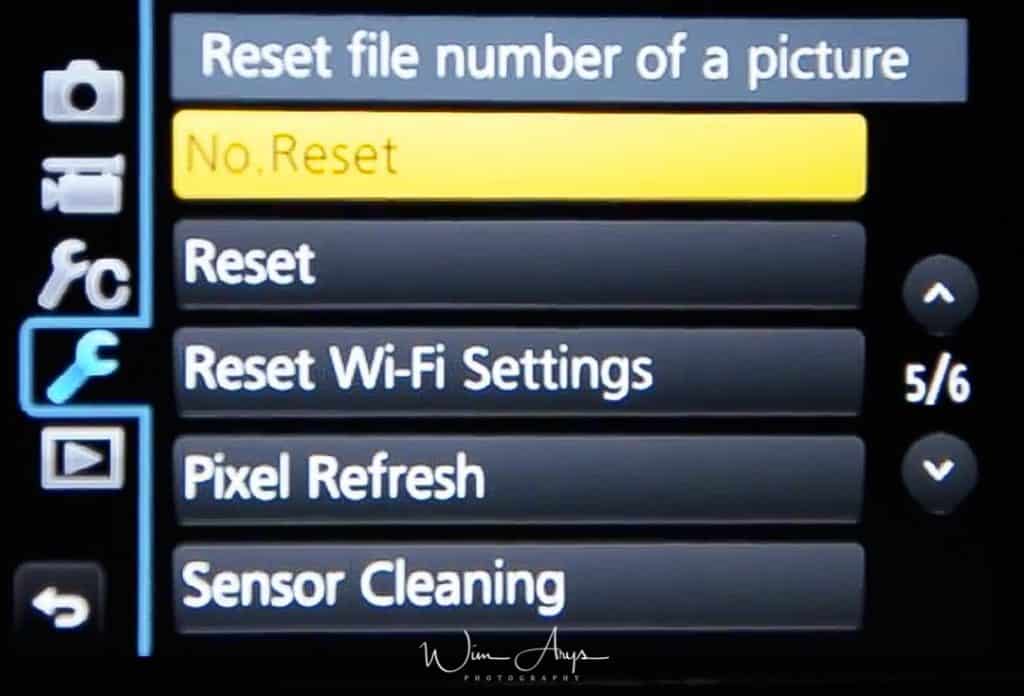
No.Reset
Reset the file number of the next recording to 0001.
Reset
The following settings are reset to the default:
- Recording settings.
- Setup settings Wi-Fi Setup and Bluetooth settings.
- Custom settings (Face Recog. and[Profile Setup settings.
- Setup/custom settings (except for Wi-Fi Setup, Bluetooth, Face Recog. and Profile Setup).
Reset Wi-Fi Settings
Reset all Wi-Fi settings used.
Pixel Refresh
It will perform optimization of imaging device and image processing. Use this function when you start seeing hot or dead pixels in your images.
Sensor Cleaning
Dust reduction to blow off the debris and dust that have affixed to the front of the imaging device is performed.Level
MENU → Setup Menu → page 6 of 6 (General Camera Setup)
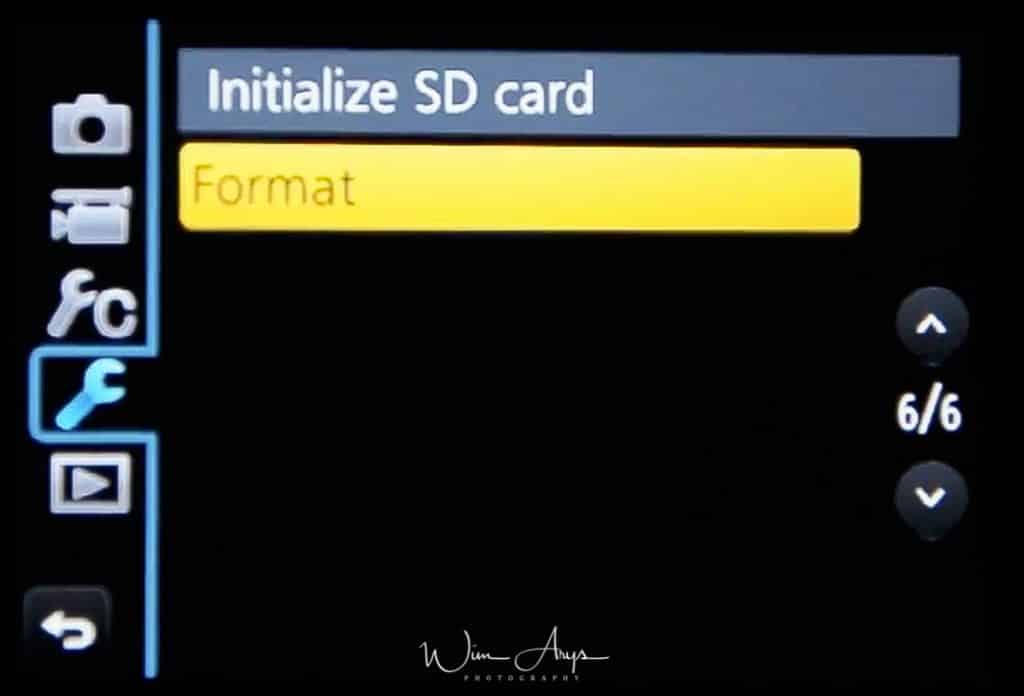
Format
Format the card before recording with the camera. Always a good idea to format every time you start a new shoot in order to maintain the integrity of the SD card.
Since data cannot be recovered after formatting, make sure to back up necessary data in advance.
MENU → Playback Menu → Page 1 of 4
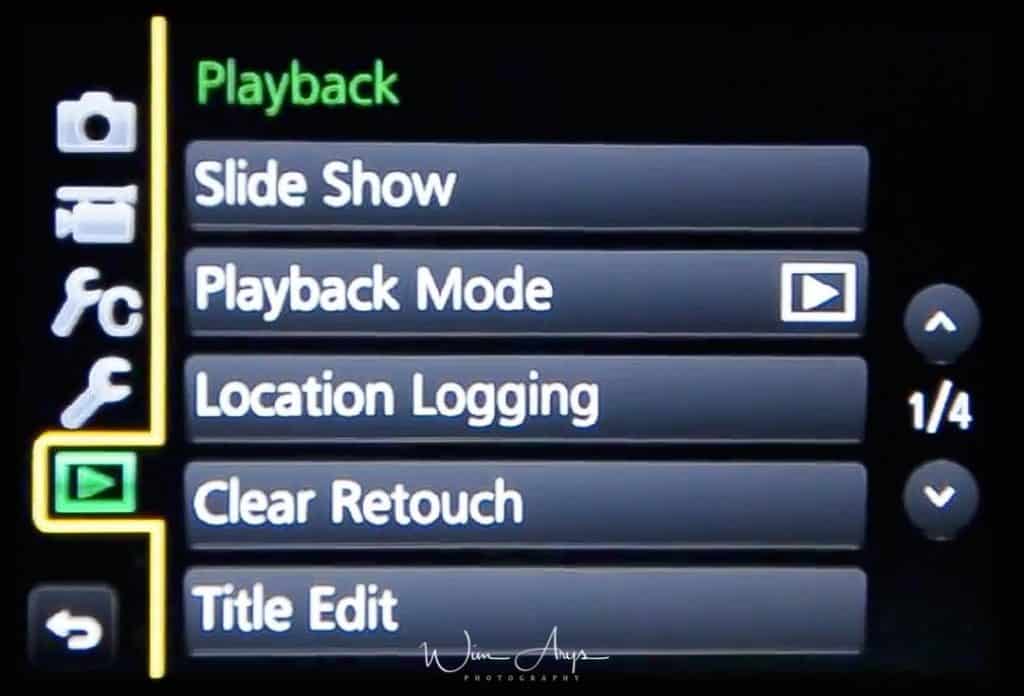
Slide Show
ou can play back the pictures you have taken in synchronization with music, and you can do this in sequence while leaving a fixed interval between each of the pictures.
You can also put together a slide show composed of only still pictures, only motion pictures, etc.
You can change the settings for slide show playback by selecting [Effect] or [Setup] on the slide show menu screen.
Playback Mode
Playback in Normal Play, Picture Only or Video Only can be selected.
Location Logging
You can write location information sent from a smartphone (latitude and longitude) on images.
You need to install “Panasonic Image App” on your smartphone to do this.
Clear Retouch
Remove unwanted objects and such right from the Lumix GX7 menu. The erasure operation can only be performed by touching. Clear Retouch automatically enables the touch operation.
Title Edit
You can add text (comments) to pictures. After text has been registered, it can be stamped in prints using the Text Stamp. Just select the picture you want and edit the text.
MENU → Playback Menu → Page 2 of 4
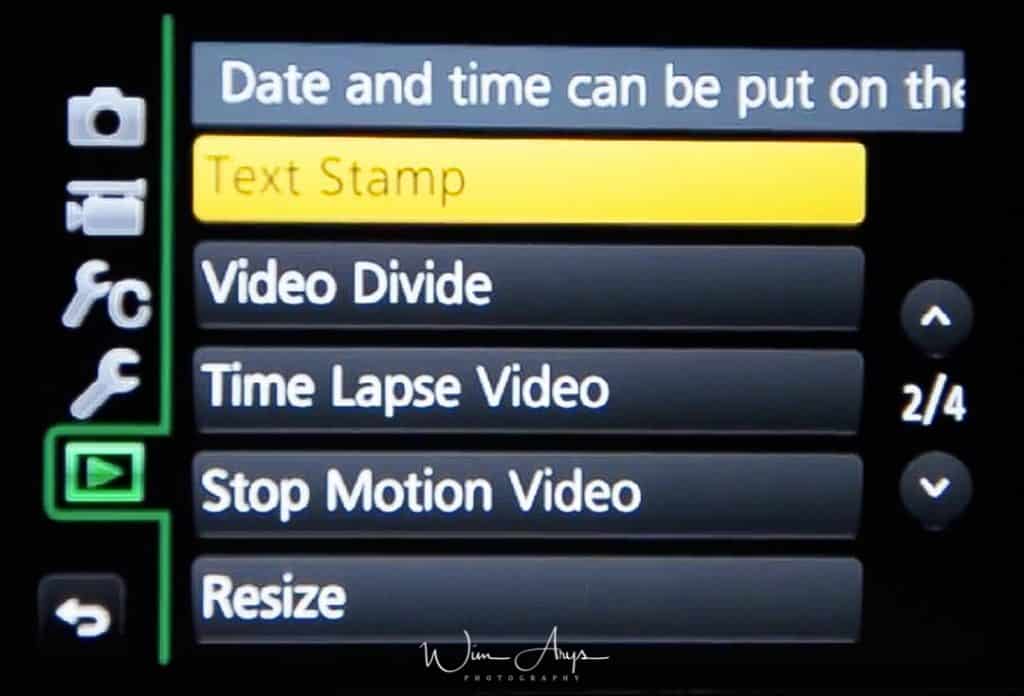
Text Stamp
You can stamp recording information like names, dates, places on recorded images.
Video Divide
Recorded motion picture and 4K burst files can be divided in two. It is recommended for when you want to divide a part you need with a part you do not need.
Time Lapse Video
This function allows you to create a motion picture from a picture group recorded with Time Lapse Shot.
Stop Motion Video
A Motion picture is created from group pictures taken with Stop Motion Animation.
Resize
To allow easy posting to web pages, attachment to e-mail etc., picture size (number of pixels) is reduced.
MENU → Playback Menu → Page 3 of 4
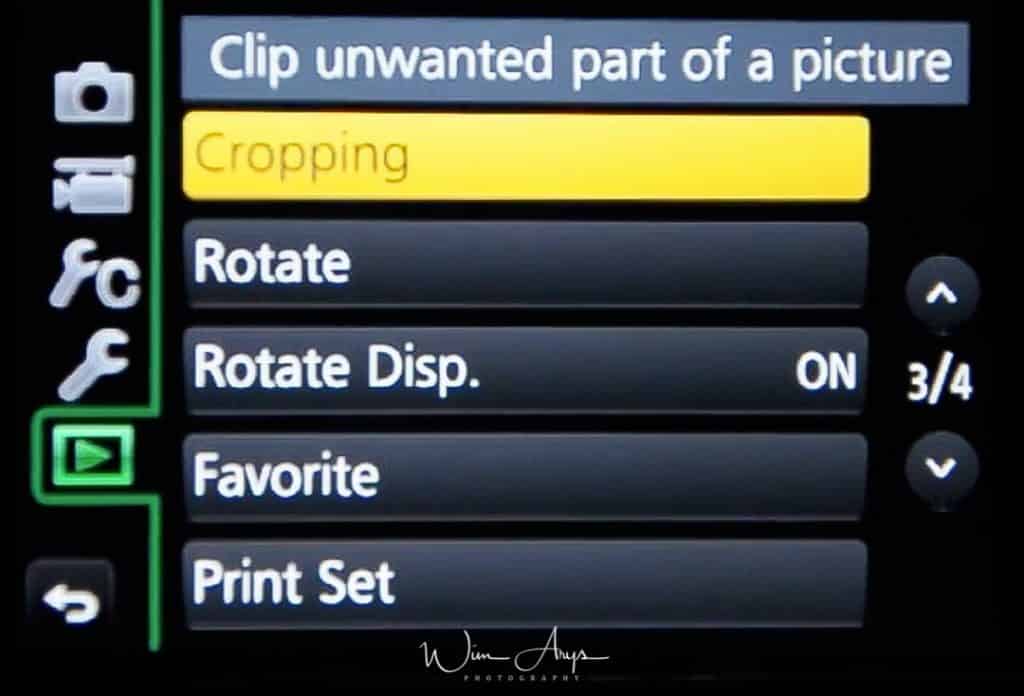
Cropping
You can enlarge and then clip the important part of the recorded picture.
Rotate
Rotate pictures manually in 90 degree steps.
Rotate Disp.
This mode allows you to display pictures vertically if they were recorded holding the Lumix GX7 vertically.
Favorite
You can do the following if a mark has been added to pictures and they have been set as favourites:
- Play back the pictures set as favourites only as a slide show.
- Play back only the pictures set as favourites. ([Favorite Play)
- Delete all the pictures not set as favourites. (All Delete Except Favourite)
Print Set
DPOF “Digital Print Order Format” is a system that allows the user to select which pictures to print, how many copies of each picture to print and whether or not to print the recording date on the pictures when using a DPOF compatible photo printer or photo printing store.
MENU → Playback Menu → Page 4 of 4
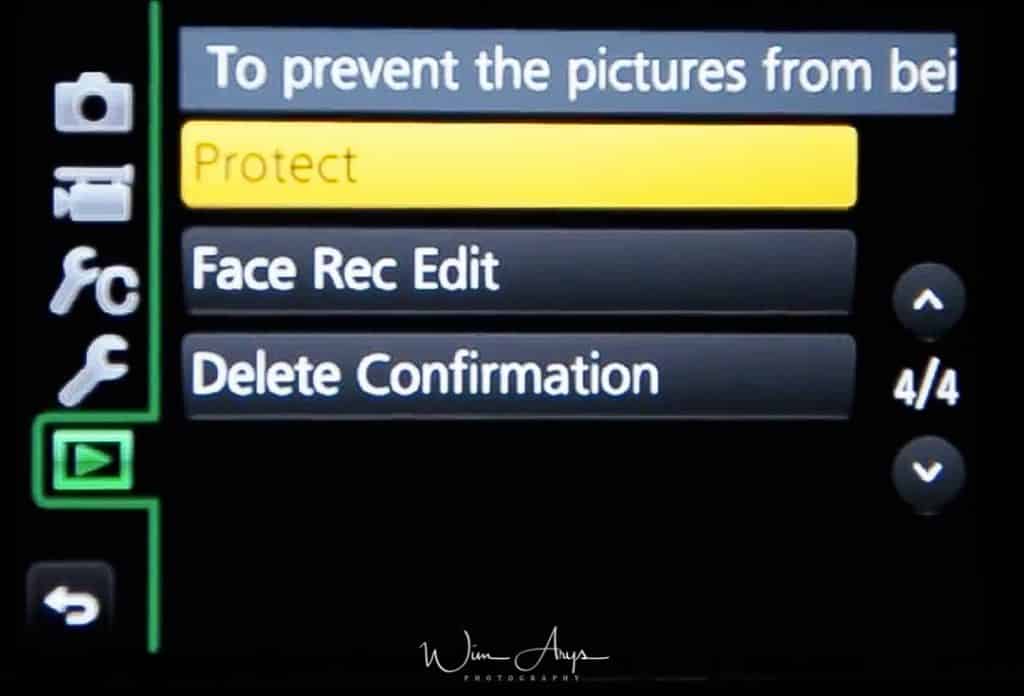
Protect
You can set protection for pictures you do not want to delete by mistake.
Face Rec Edit
You can clear and replace all information relating to face recognition in selected images.
Delete Confirmation
This sets which option, Yes or No, will be highlighted first when the confirmation screen for deleting a picture is displayed.
Quick access with the Q Menu (Fn 1 )
The most commonly used settings can be accessed through what is called the Q Menu. This is the FN1 button that you’ll find right next to the screen, above the trash bucket button.
The features that can be adjusted using Quick Menu are determined by the mode or a display style the camera is in.
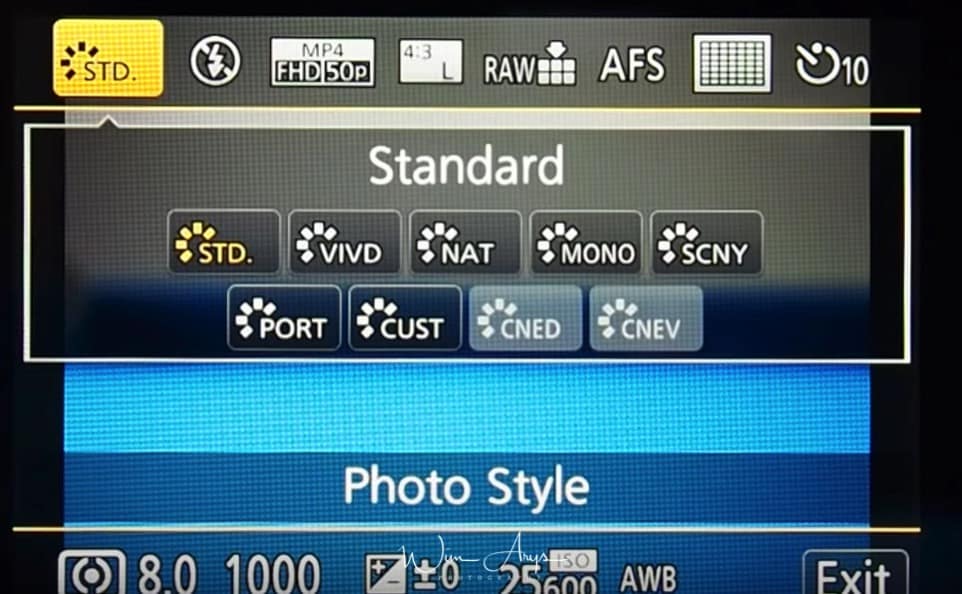
Photo Style
This applies only to Jpeg images, and the RAW preview when you load them into an app like Lightroom.. You can select a colour effect here.
- Standard: standard Panasonic colour and contrast rendering.
- Vivid: Brilliant effect with high saturation and contrast.
- Natural: Soft effect with low contrast.
- Monochrome: Monochrome (black and white)effect with no color shades.
- Scenery: An effect appropriate for sceneries with vivid blue skies and greens.
- Portrait: An effect appropriate for portraits with a healthy and beautiful skin tone.
- Custom: Make your own presets for easy recall when needed.
- Cinelike D: Gives priority to the dynamic range by using a gamma curve designed to create film-like images. Suited for editing.
- Cinelike V: Gives priority to the contrast by using a gamma curve designed to create film-like images.
As mentioned earlier, it’s possible to create your own Photo Style or customise the preset styles. This is basically a way of hacking into the Jpeg engine and adjusting it to your own style and preferences. There are 6 areas that you can alter.
- Contrast: add or decrease the difference between the brightness and the darkness in the picture.
- Sharpness: add a degree of sharpness or make your images softer.
- Noise Reduction: add noise reduction for high ISO shooting.
- Saturation: add more vividness to the colours. Or remove some.
- Color Tone: add a blue, orange, red or green filter to your image.
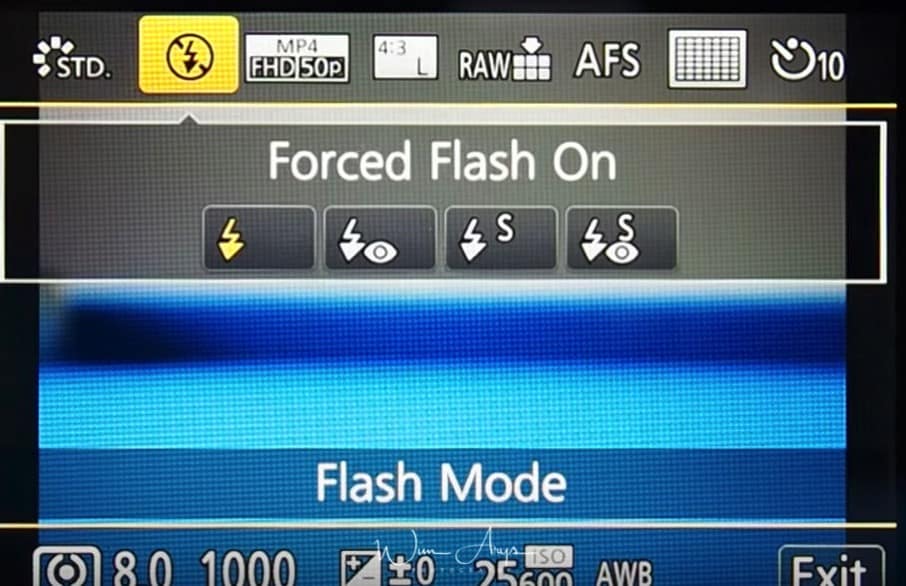
Flash Mode
Set the built-in flash to a suitable setting:
- Forced Flash On: The flash is activated every time regardless of the recording conditions.
- Forced On/ Red-Eye: The flash is activated every time regardless of the recording conditions. A pre-flash is given to counter the so-called red-eye flash phenomenon.
- Slow Sync: When taking pictures against a dark background landscape, this feature will slow the shutter speed when the flash is activated. Dark background landscape will appear brighter. Use this when you take pictures of people in front of a dark background.
- Slow Sync./ Red-Eye: When taking pictures against a dark background landscape, this feature will slow the shutter speed when the flash is activated. A pre-flash is given to counter the so-called red-eye flash phenomenon.
Motion Pic. Set
You can change bitrate and frame-rate for video here, as well as select the appropriate movie container.
AVCHD

MP4

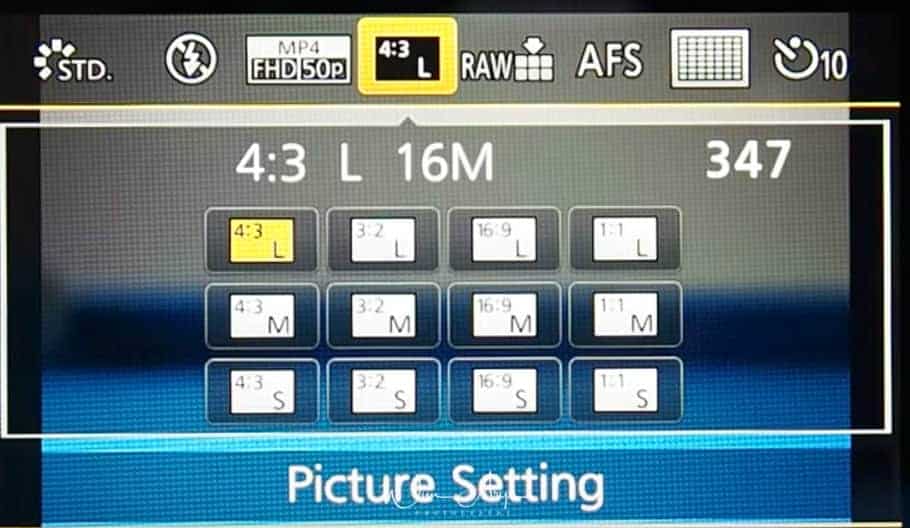
Picture Setting
You can quickly change picture size and picture quality here for your Jpeg’s.
These are the aspect ratios available:
- 4:3: native sensor ratio
- 3:2: the ratio used in full frame cameras
- 16:9: for a wider looking view
- 1:1: Square aspect ratio, mostly used for social sharing
Quality wise, you can choose between Small (S), Medium (M) and Large (L) files sizes. Obviously, Large will have the best quality Jpeg’s, at the expense of larger files. If you only shoot Jpeg (and not RAW) set it to Large. If you shoot both (Jpeg+RAW, see next screen), you could set it to small or medium since you’ll always work with the RAW in post processing. This way, you’ll still have a Jpeg for sharing quickly online or as a reference whilst still saving some space.
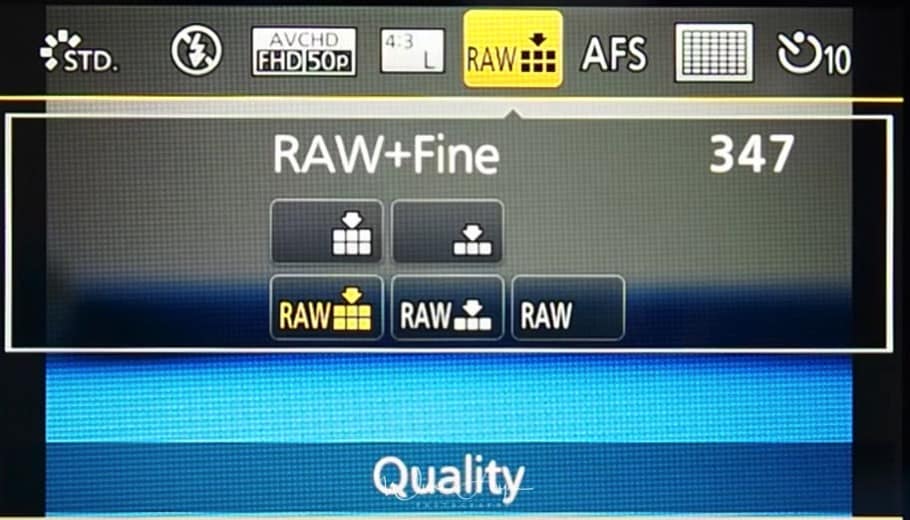
Quality
Probably the most important setting is Quality. You can select either Jpeg, where the RAW data from the sensor is processed by an in-camera algorithm to produce a viewable image, or save your images in this RAW format. RAW retains all the data of the sensor, and is meant to be edited afterwards in a desktop application like Lightroom. Saving as RAW means that you have much more creative freedom afterwards to push shadows or pull highlights, sharpen and enhance your image in any way you please. A Jpeg retains only a fraction of this information, according to the algorithm inside the Panasonic Lumix GX7 which might or might not suit your style and/or needs.
Hence, my recommendation is always to shoot RAW or RAW Jpeg. This does mean larger files, but SD cards are inexpensive compared to your beautiful new Lumix. But some photographers prefer to shoot in Jpeg only because they are for instance not interested in post-processing images. In this case, I would set the Jpeg to the highest quality setting.
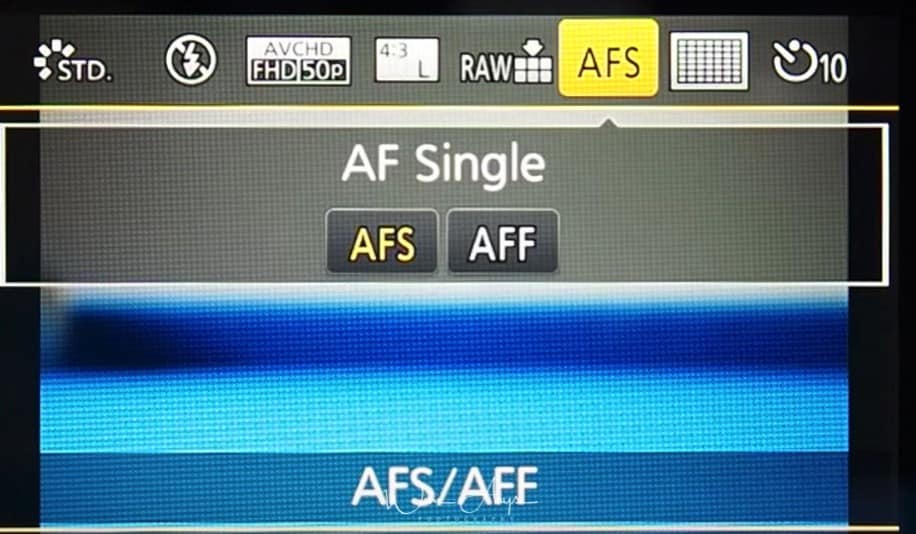
AFS/AFF
AFS is an abbreviation of Auto Focus Single and AFF is an abbreviation of Auto Focus Flexible. In AFS, the focus stays locked while the shutter button is pressed halfway and in AFF focus is continuously readjusted according to the movement of the subject. See AFF as a function between Single AF and Continuous AF.
Some more info on these modes for clarification:
- AFS will find focus and stay focused at that distance until you take a photo or release the shutter button. This is handy if you want to focus and then recompose your shot for instance.
- AFF will do the same unless it detects subject movement, at which time it will temporarily switch to AFC operation in order to re-focus.
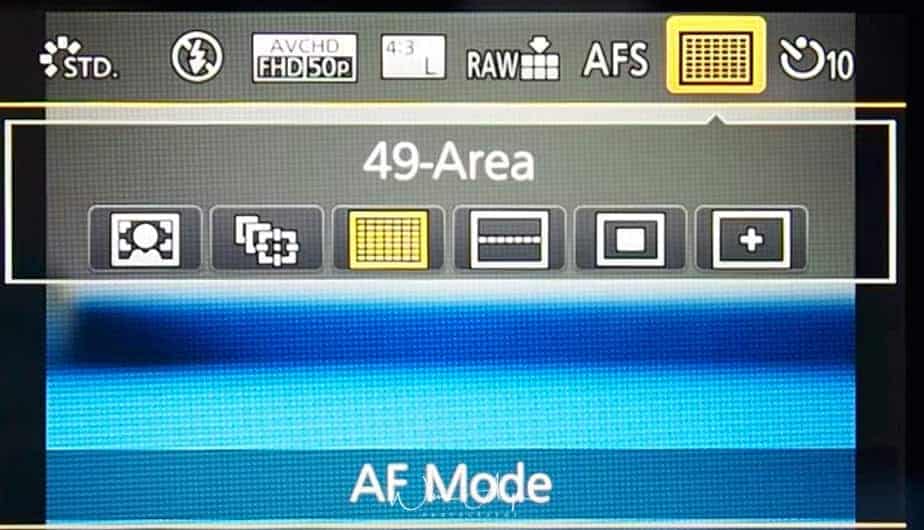
AF Mode
This allows the focusing method that suits the positions and number of the subjects to be selected. There are 6 different methods available, each suited for different scenarios.
Face/Eye Detection
A person’s face, eyes, and body (the entire body or the upper half of the body) are automatically detected.
When the camera detects a person’s face or body, an AF area is displayed over the detected person.
- Yellow: This is the AF area for the person to be brought into focus. The Lumix GX7 automatically selects the person.
- White: These are the AF areas for people other than the person to be brought into focus. This type of AF area is displayed when more than one person is detected.
When a person’s face or eyes are detected, the eye closer to the camera will be brought into focus, if the eyes are inside the yellow frame.
The Lumix GX7 can detect the faces of up to 15 people. To specify the person or eye to be brought into focus, align an AF area with the desired person or eye. You can do so easily by touching a person indicated with an AF area.
Tracking
The camera keeps adjusting the focus and exposure automatically to the specified moving object. Perform either of the following operations to lock the subject to be tracked:
- Use a button: aim the AF tracking frame D over the subject, and press the shutter button halfway.
- Use the touch screen: touch the subject on the screen.
If it fails to lock, AF area will flash in red, and disappear.
The AF area turns yellow while the subject is locked and green while the shutter button is pressed halfway. Press the Menu button to cancel the lock.
49 Area
Widest setting with all AF points used. Up to 49 AF areas can be focused. This is effective when your subject is not in the center of the screen.
Custom Multi
From among 49 AF areas, you can freely set the optimum shape of the AF area for the subject.
1-Area
The camera focuses on the subject in the AF area on the screen.
Pinpoint
You can achieve a more precise focus on a point that is smaller than 1-Area. If you press the shutter button halfway, the screen that lets you check the focus by enlarging it.
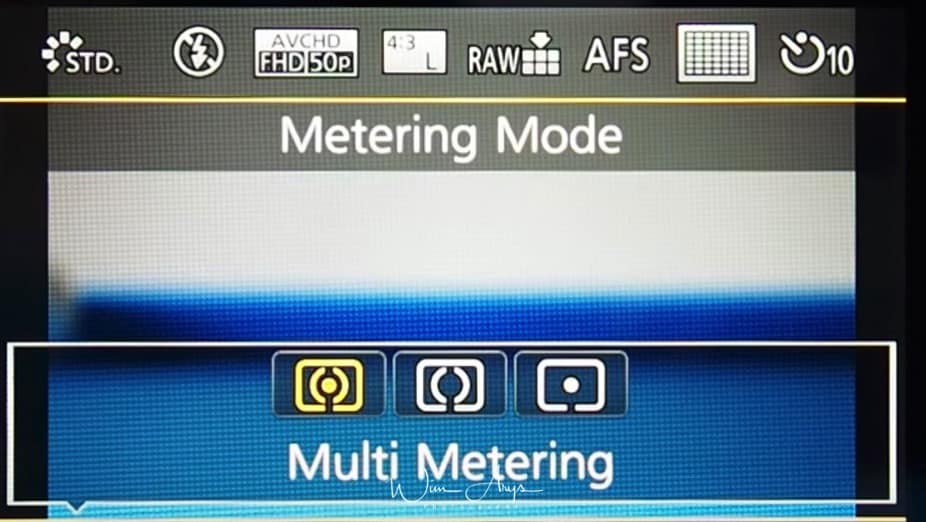
Metering Mode
You can change how the light is metered here, and hence how a correct exposure is calculated by the Lumix GX7. If you feel that the camera takes over- or underexposed images according to your personal preferences, it might be worth changing the metering mode.
Implementation of this is quite basic in this camera, you have a total of only 3 methods to choose from:
- Multiple: This is the method in which the camera measures the most suitable exposure by judging the allocation of brightness on the whole screen automatically.
- Center weighted: This is the method used to focus on the subject on the center of the screen and measure the whole screen evenly.
- Spot: This is the method to measure the subject in the spot metering target.
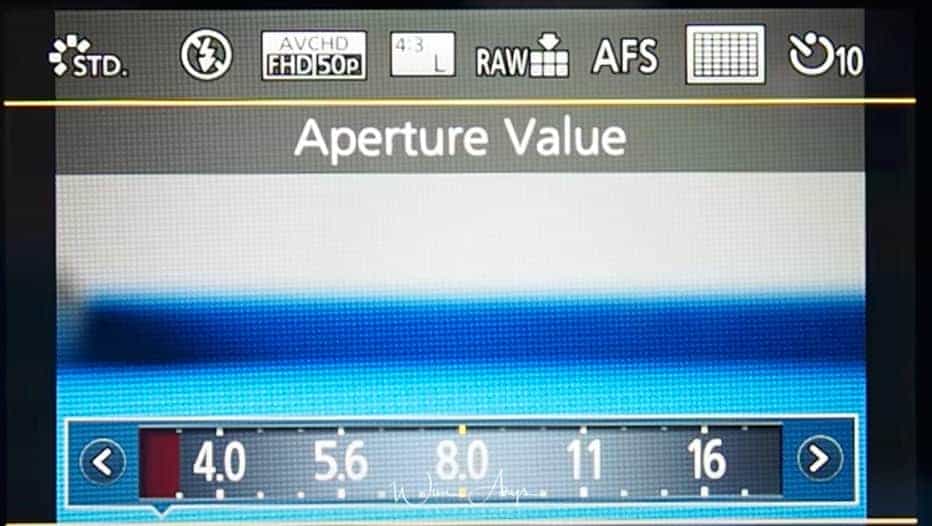
Aperture Value
Manually change the aperture of your lens here.
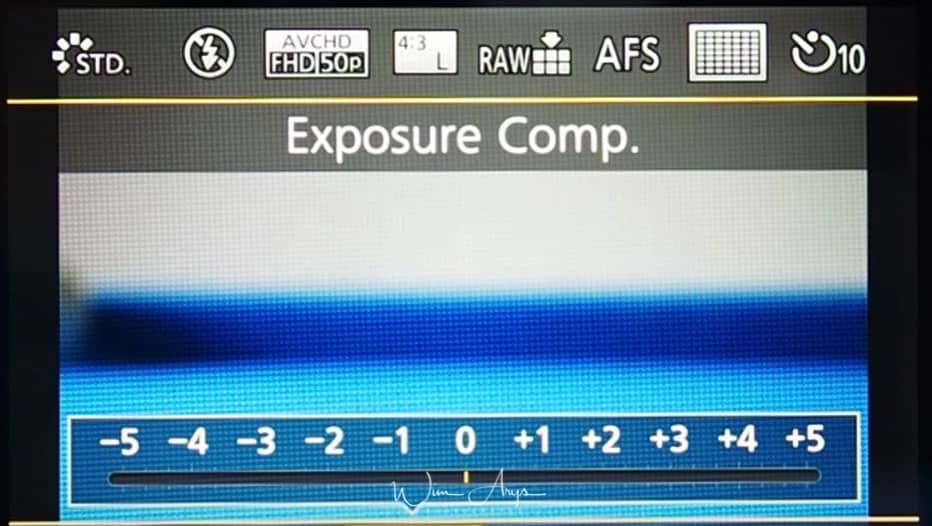
Exposure Comp
If you feel like your Lumix GX7 is over- or underexposing your images (or you want to purposely underexpose), you can dial in what is called exposure compensation here. A range of plus minus 5 is available here to correct the auto exposure of the camera.
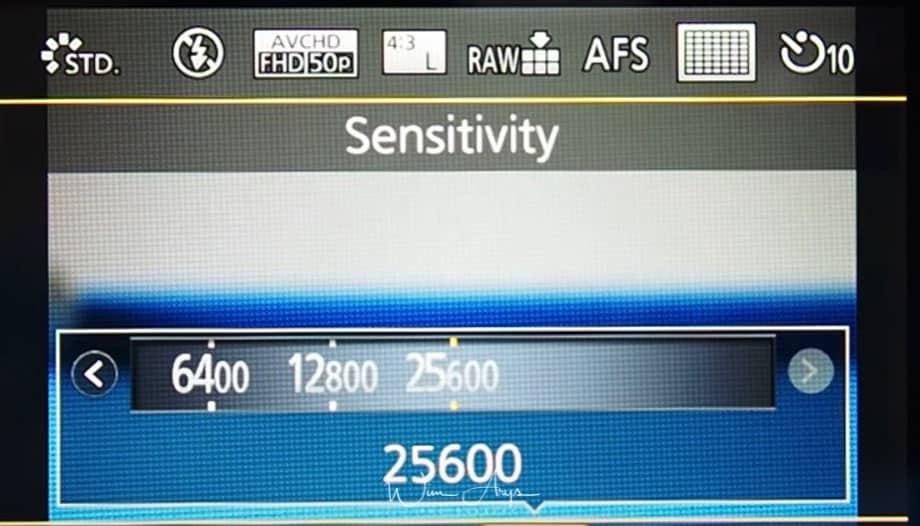
ISO sensitivity
Sets the upper and lower limits of the ISO sensitivity when you use Auto ISO or i ISO. Lower Limit should be set to 200 and upper limit to 3200, this is the range where you’ll get usable images without too much noise.
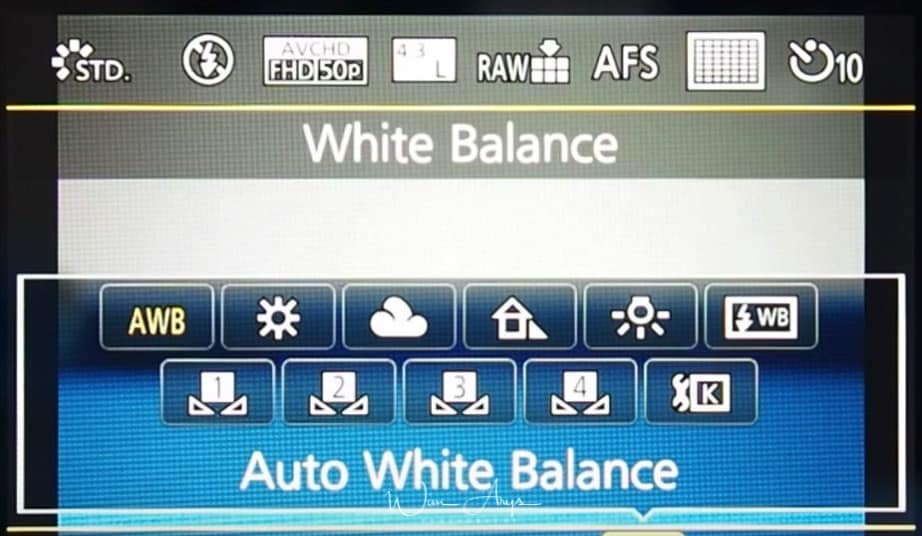
White Balance
Manually change white balance here or choose a preset.
- AWB: Automatic adjustment.
- Sun: When taking pictures outdoors under a clear sky.
- Cloudy: When taking pictures outdoors under a cloudy sky.
- Shade: When taking pictures outdoors in the shade.
- Incandescent Lights: When taking pictures under incandescent lights.
- Flash: When taking pictures with the flash only.
- Manual presets: The manually set value is used.
- Color temperature: When using the preset color temperature setting.
Conclusion
Take some time to go through of all the Panasonic GX7 Menu items, with pointers, tips and tricks along the way. This information should get you familiarised with this fantastic mirrorless camera. If you would like any clarification or extra information on any functionality here, let me know through the comment section below. Happy shooting!

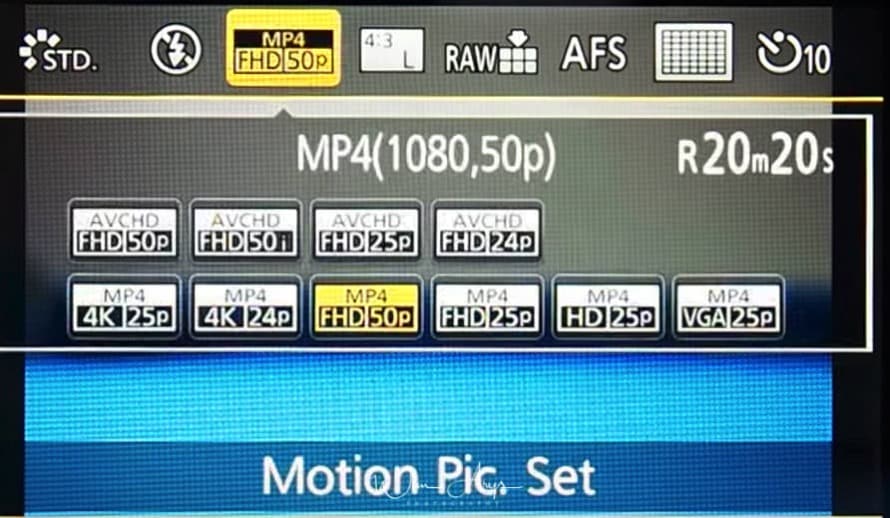


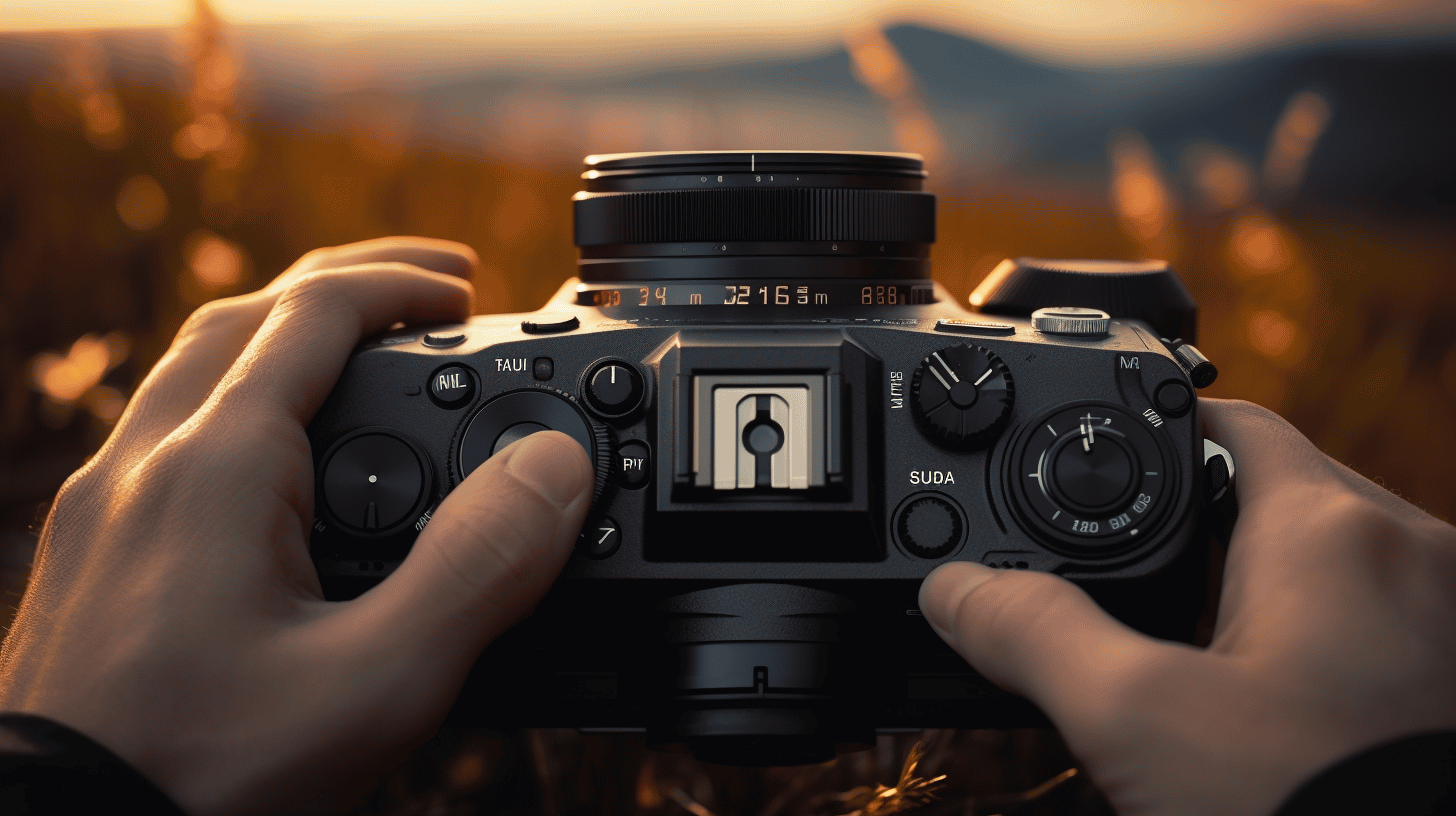
Hi. I’ve been experimenting with a G7 with a 100-300 zoom but I find the processor just can’t focus quickly enough. Speed of the processor chip is never mentioned in revews so I’m questioning if a G9 or another camera has a significantly faster processor chip that gives better auto-focus ability? Thank you.
Hi Terry, not every new model has a faster processor, but I’m sure that the G9 does. And yes this should impact autofocus favourably.
I just bought a secondhand lumix g7 several months ago, and i haven’t explored much already. Mainly because i didnt really know what to do with it…
now this article just gives me lots of feature info I just need to try.
Thanks for making this article, it means a lot to beginner photographer like me…
No problem, have fun.
I’m not that proficient with the gx7 and I want to shoot some newborn pictures with it. I want to shoot with auto so that I can focus more on posing then shooting quickly. Which kit lens should I use that came with the camera and can I use portrait mode in auto?
Hi Lola, auto is fine, but I would use a prime lens like the fantastic Olympus M.Zuiko ED 75mm f/1.8 or Panasonic Lumix G 42.5mm f/1.7 POWER O.I.S. if you want to get a bit closer.
Thank you,
I followed your instruction on assigning various functions to various buttons, it works, fine; however, when the camera is turned off and back on everything reverts to as was prior to my adjustments! Is there a way to lock in the adjustments please?
i own a g7and your tips and tricks are great! Thank you!
Would have loved to be able to copy this great Tips&Tricks4G7 write-up. Unfortunately, copy/paste will not allow me to ‘capture’ the images provided as (non-text) parts of the article. Shame.
Although I’ve tried in both manual and auto focus modes, I’ve not been able to locate focus bracketing on my GX7. How do I find it?
Easiest way is pressing the ‘down’button on the cursor on the back and then select bracket Larry.